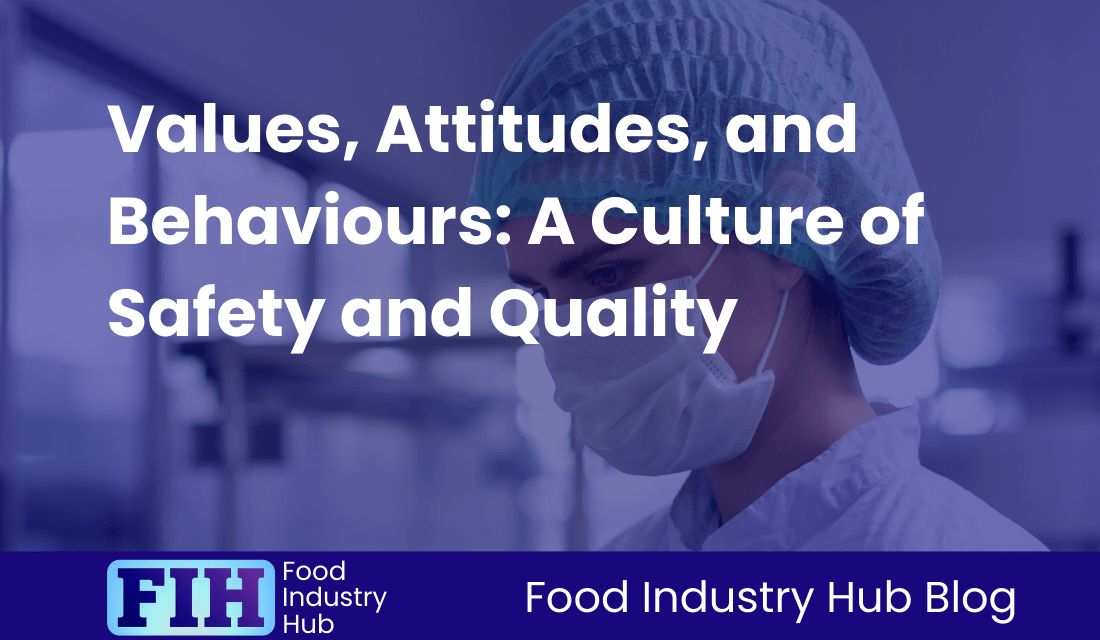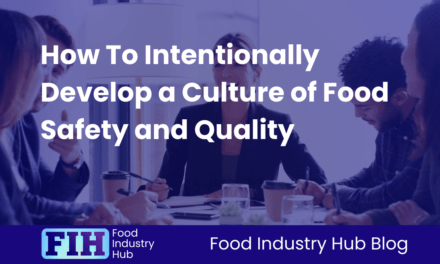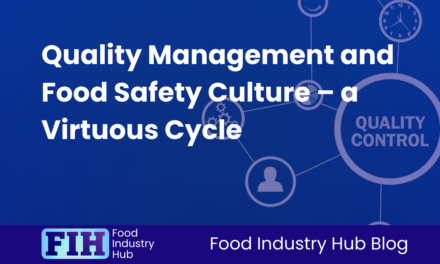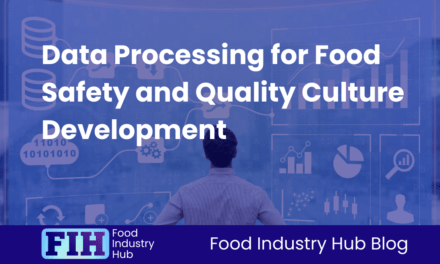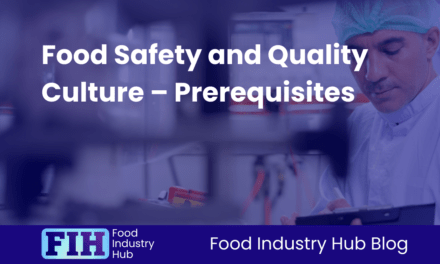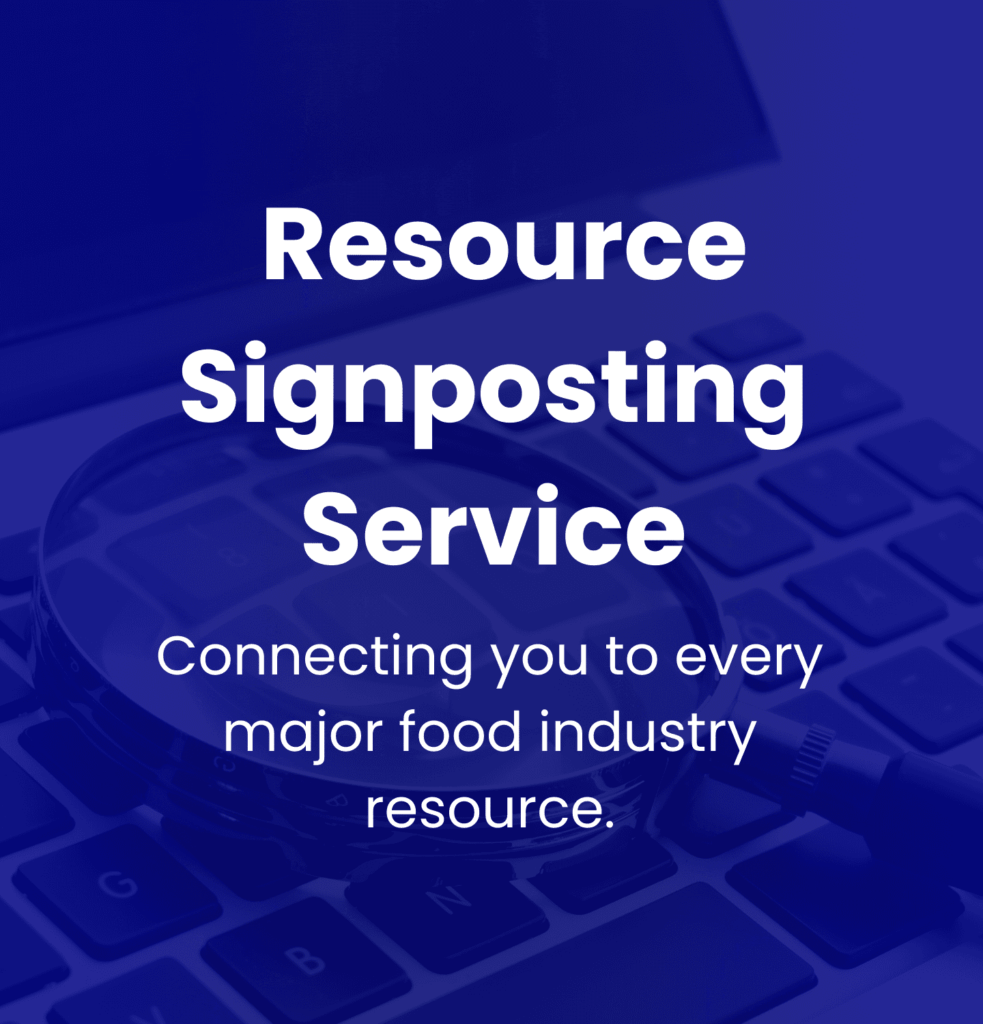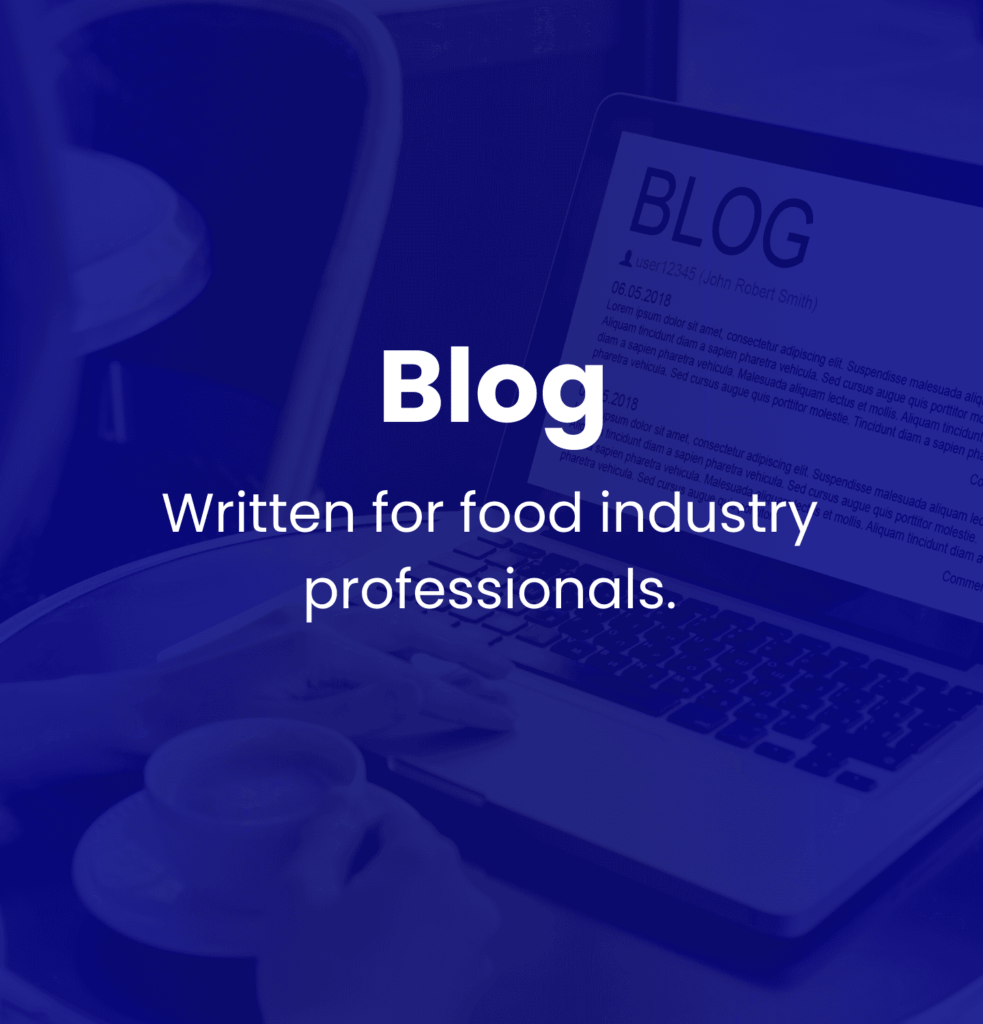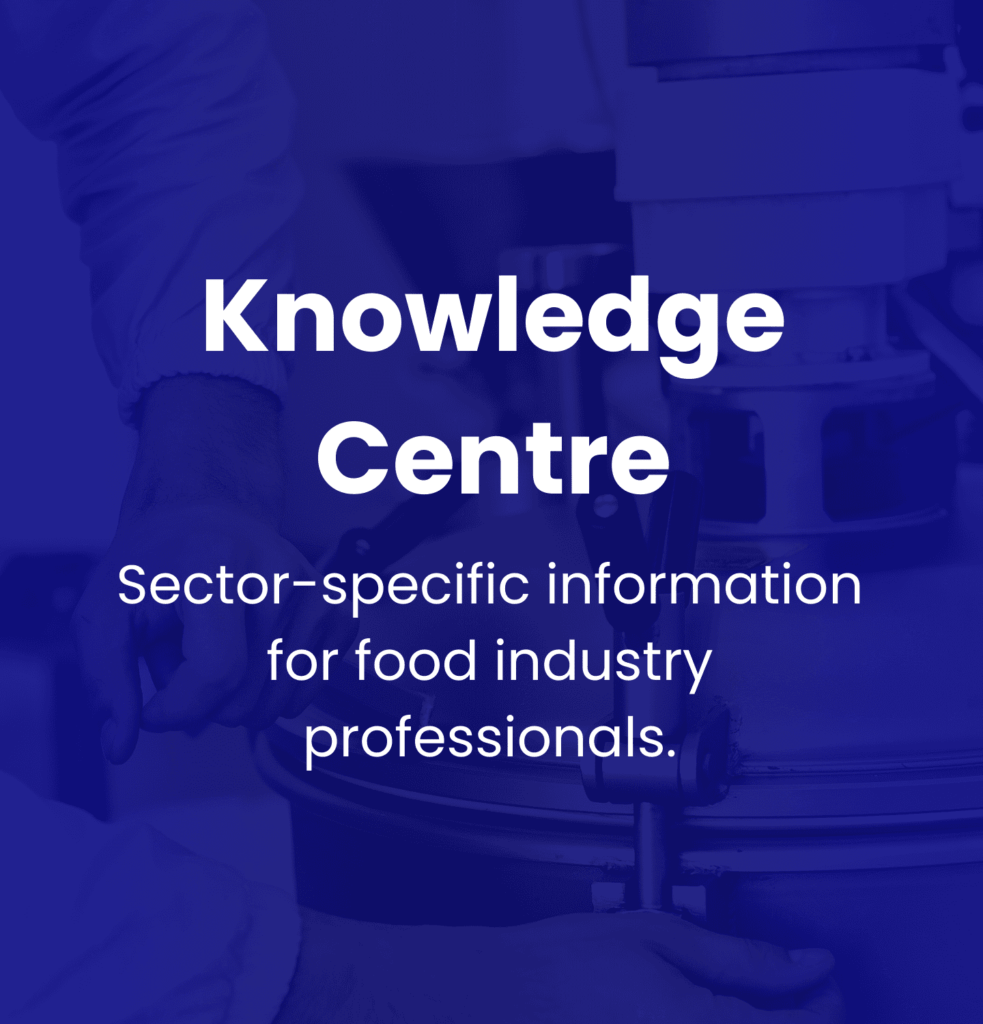Introduction
The culture of safety and quality within your organisation is not just dictated by policies and procedures; it’s shaped by the values you espouse, the attitudes you cultivate, and the behaviours you reward. So how do you ensure that the values you’ve put in place are truly influencing attitudes and guiding behaviours? And more importantly, how do you gauge the maturity of your safety culture? It’s a complex process, but it’s essential for the success of any organisation. Let’s unpack this together.
This post is part of a collection we’ve put together to explore the topic of food safety and quality culture, and you can explore the topic in more detail by browsing the related content.
Table of Contents
Key Takeaways
- Values/ideals result in attitudes/dispositions, which are manifested as behaviours/decisions.
- Aligning food safety and quality values with business objectives is foundational to building a culture of safety and quality.
- Effective communication of values and setting clear expectations can shape attitudes and behaviours towards food safety and quality.
- Managerial decisions and actions should be guided by food safety and quality values to reinforce a positive culture.
- Organisational values create a framework for decisions – positively impacting safety and quality.
- Positive behaviours emerge from values-driven attitudes, promoting consistent safety practices.
- Leadership must model values to inspire a safety-focused culture.
- Accountability promotes adherence to quality and safety protocols.
- Regular training embeds values, supporting continual improvement.
- A values-driven approach creates a resilient, safety-focused organisational culture.

Values, Attitudes, and Behaviours
Values and ideals shape attitudes and dispositions, which are then expressed through behaviours and decisions. In any organisation, the deeply held values of its members inform how they think, feel, and respond to different situations.
These underlying attitudes and dispositions directly influence the choices employees make -both consciously and subconsciously- in their daily tasks and interactions. For food manufacturers, where every decision can impact product safety, quality, and consumer trust, nurturing values aligned with food safety and quality is essential for cultivating a proactive and reliable culture.
Values and Ideals as the Foundation of Attitudes and Dispositions
Values are the principles that individuals and organisations hold as essential and enduring, such as integrity, accountability, and a commitment to quality. These values shape how employees perceive their responsibilities and their roles within the organisation. In the context of food safety and quality, values like diligence, accuracy, and consumer welfare set the foundation for attitudes that prioritise safety above convenience or cost-cutting. When an organisation clearly articulates and demonstrates these values, employees internalise them, forming a shared understanding of what matters most.
When food safety and quality values are embedded within an organisation, employees develop attitudes and dispositions that reflect these priorities. For instance, if ‘protecting consumer health’ is a core value, employees are more likely to adopt a conscientious disposition toward their work, seeing food safety as a personal responsibility. They become vigilant, detail-oriented, and proactive in identifying risks, not simply because protocols dictate these actions, but because they genuinely care about upholding a standard that protects others.
Attitudes and Dispositions Manifesting as Behaviours
The values-driven attitudes employees hold translate into observable behaviours in the workplace. These behaviours include everyday choices and interactions that determine the quality of products and the safety of processes. For example, employees who value safety are likely to follow established procedures meticulously, report potential hazards without hesitation, and collaborate openly with peers to resolve quality concerns. In contrast, if these values are weak or absent, behaviours may become inconsistent, with employees overlooking steps, delaying responses to issues, or avoiding responsibility.
These behaviours are significant because, over time, they establish behavioural norms that define the organisation’s culture. In food manufacturing, where product integrity can be significantly impacted by small lapses, the behaviours employees consistently exhibit become the baseline for cultural maturity. If food safety and quality values are robustly integrated, employees make decisions aligned with these ideals, creating a culture that reliably supports product safety and consumer trust.
The Significance of Value-Aligned Culture Development
For food safety and quality culture, the sequence from values to attitudes to behaviours is foundational because it explains a causal flow that drives the actions and behaviours that determine the safety and quality of the food produced.
Values ensure that employees hold a common standard of importance toward safety and quality, which then nurtures positive dispositions that directly impact decision-making. When values-driven attitudes permeate the workforce, they build into a proactive, vigilant culture where food safety and quality are prioritised in every decision, large or small. This influence becomes particularly important when facing high-pressure scenarios or operational challenges, as employees grounded in these values are less likely to compromise standards.
A mature food safety culture, driven by strong values, enables food manufacturers to build consistency, accountability, and resilience across all operations. It helps ensure that quality and safety are upheld not only during audits or inspections but as part of everyday business. This type of culture results in an environment where employees take ownership of their actions and make decisions that reflect a shared commitment to excellence. In doing so, the organisation reduces the risk of safety incidents, enhances product reliability, and strengthens consumer confidence, ultimately supporting both public health and brand reputation.
The alignment of values, attitudes, and behaviours creates a foundation that allows food safety and quality to flourish as central elements of an organisation’s identity. By recognising that values shape attitudes and dispositions, which in turn influence behaviours and decision-making, food manufacturers can focus on cultivating a culture that genuinely embodies its core values. This alignment not only strengthens food safety and quality practices but also transforms them into ingrained, sustainable aspects of the business, fostering a safer and more reliable food supply for all.

Food Safety and Quality Values
For food safety and quality culture, values and ideals create the underlying attitudes and dispositions that drive behaviours and decisions. Values like integrity, accountability, and commitment to excellence shape how individuals and teams perceive their responsibilities and guide their approach to food safety challenges.
When values are deeply embedded, they naturally lead to specific attitudes, such as diligence, caution, and vigilance. For example, an organisation that values consumer protection and continuous improvement develops a disposition among its employees to proactively look for potential hazards, prioritise safety, and view compliance as a starting point rather than an endpoint. This collective disposition becomes part of the company’s fabric, influencing how each person reacts to daily tasks, unexpected incidents, or new regulations.
These attitudes and dispositions then manifest as behaviours and decisions. A team driven by integrity and accountability is more likely to report issues honestly, double-check procedures, and take swift corrective action when necessary. Decisions are made with a consumer-centric focus, reflecting the priority of safety and quality over things like convenience or cost-cutting. As a result, the organisation not only meets regulatory standards but also establishes a reputation for trustworthiness and dedication to quality.
In short, the values and ideals of a strong food safety culture result in the attitudes and dispositions that consistently influence actions, helping ensure that every decision aligns with the mission of protecting consumers and delivering quality. This seamless transition from values to actions creates an environment where food safety is an ingrained priority, consistently upheld through intentional behaviours and informed decision-making.
Clearly Articulating Food Dafety and Quality Values
For food manufacturing businesses, specifically identifying core food safety and quality values is crucial to establishing a reliable foundation for decision-making. These foundational values act as guiding principles, setting the expectations for how decisions are made and ensuring that actions consistently align with the company’s commitment to safety and quality. When a business takes the time to define these values, it establishes a clear and consistent reference point that informs every decision, from day-to-day operations to strategic planning.
Identifying core values such as integrity, accountability, consumer protection, and commitment to continuous improvement provides employees at all levels with a set of standards that guide their choices – even in complex situations. For example, if integrity is a foundational value, employees understand the importance of transparency and honesty in every aspect of production, whether that involves reporting quality concerns, complying with testing protocols, or ensuring proper labelling. When consumer protection is a key value, the organisation prioritises decisions that put consumer health first, even if it means slowing down production to address a potential issue.
These values also serve as a stabilising force during unexpected challenges. In the event of a contamination threat, a company with clearly articulated food safety values can respond decisively, as employees already understand that safety takes precedence over competing priorities like production quotas. This clarity reduces hesitation, empowering employees to act quickly and correctly. Without defined core values, decision-making can become inconsistent or compromised, with individuals potentially prioritising conflicting goals or acting under uncertainty.
Having clearly defined values can enhance employee engagement and buy-in. When workers are aware of the business’s guiding principles, they may be more likely to adopt those values personally – creating a culture where safety and quality are embraced as shared commitments rather than imposed rules. This alignment fosters accountability, as employees at every level feel a shared responsibility to the values themselves, rather than to authority figures who enforce rules.
For food manufacturing businesses, the process of identifying and communicating core food safety and quality values is more than an exercise in branding. These values create a structured framework that consistently influences behaviour, aligns decision-making with the company’s mission, and ultimately fosters a culture where safety and quality are the natural outcomes of every decision.
Aligning Food Safety and Quality Values with the Food Manufacturer’s Business Objectives
Aligning food safety and quality values with a food manufacturer’s business objectives is essential for creating a cohesive, purpose-driven organisation. When food safety and quality values are deeply integrated with business objectives—such as market growth, operational efficiency, and brand reputation—they don’t exist in isolation but rather support the broader goals of the organisation. This alignment ensures that safety and quality are viewed not as separate from business success, but as essential to it.
When a company makes food safety and quality values central to its objectives, it signals to employees, stakeholders, and consumers that these are non-negotiable priorities that directly contribute to the company’s mission and long-term success. For instance, objectives around market expansion and consumer trust are inherently linked to delivering safe, high-quality products. A brand known for its commitment to safety and quality is more likely to enjoy customer loyalty, higher sales, and competitive advantages in new markets. By explicitly connecting these values to growth-oriented goals, companies create an environment where everyone understands that safety and quality are pathways to achieving sustainable success.
Operational efficiency is another business objective that aligns well with food safety and quality values. Companies that prioritise efficient, quality-focused processes are not only better at meeting regulatory standards but also at minimising costly recalls, reducing waste, and ensuring consistency. For example, a commitment to continuous improvement—a core quality value—supports operational efficiency by encouraging employees to find ways to streamline production while maintaining safety standards. This approach leads to fewer errors, optimised resource use, and improved profitability, demonstrating that quality-driven efficiency is a sound business strategy.
Moreover, aligning values with objectives helps in making consistent, values-driven decisions even in high-stress situations. For example, in a crisis such as a product recall, having clearly defined values like transparency and consumer protection enables a company to respond with clarity, reinforcing its reputation and maintaining trust. By committing to these values as being integral to business objectives, companies are prepared to make decisions that prioritise consumer well-being without hesitation, knowing these decisions also support long-term stability and brand integrity.
This alignment also attracts top talent and supports employee retention. People are increasingly drawn to companies whose values align with their own, and employees who understand that safety and quality are central to business objectives are often more engaged and committed to upholding these standards. This collective dedication ultimately strengthens the culture, creating a workforce invested in both the company’s mission and its success.
In essence, aligning food safety and quality values with business objectives creates a unified organisation where these values act as a foundation for decision-making. They enhance the brand, drive operational efficiency, and inspire a committed workforce, proving that the pursuit of safety and quality is not only a necessity for compliance but also a strategic advantage that fuels growth, stability, and consumer trust.
Communicating Food Safety and Quality Values and Setting Expectations
Communicating food safety and quality values effectively and setting clear expectations is crucial for embedding these values throughout a food manufacturing organisation. When values and expectations are well-communicated, they help build a shared understanding across all levels of the company, ensuring that employees not only know what is expected of them but also understand why these values are fundamental to the company’s mission. This clarity turns values into actionable principles that guide daily operations, decision-making, and long-term goals.
Internal Communication: Building Awareness and Understanding
For food safety and quality values to be meaningful, they need to be woven into every aspect of internal communication. Leadership should articulate these values clearly from the outset, highlighting their importance not only as regulatory requirements but as core components of the company’s identity. Regular communication through channels such as team meetings, newsletters, and digital platforms helps keep these values top-of-mind for all employees. By presenting real-world examples of how these values are applied —such as stories of quick responses to contamination threats or continuous improvement efforts— leaders make these values relatable and tangible.
Training programs are another powerful tool for communicating food safety and quality values. For instance, training can go beyond basic procedures to explain the impact of individual actions on overall product safety and brand reputation. Programs can highlight how quality control supports consumer protection or how each step in the production process is essential to maintaining safety standards. This approach helps build a culture where employees understand the “why” behind the rules, increasing engagement and adherence.
Setting Expectations: Clarity and Consistency
Setting clear expectations is essential to translating values into actionable standards. To be effective, expectations should be specific, measurable, and aligned with the company’s food safety and quality goals. This includes clearly defining what compliance and excellence look like in each role. For example, production line workers might be expected to perform specific hygiene checks and follow contamination prevention protocols consistently, while managers might be responsible for conducting regular safety audits and leading continuous improvement initiatives.
Performance metrics and evaluation criteria should incorporate these values to reinforce their importance. By including food safety and quality metrics in performance reviews, companies show that these values are not optional, but integral to every role. This can also help to align personal and team goals with company-wide priorities. For instance, incorporating adherence to safety protocols as a KPI for departments/teams emphasises that safety and quality are as important as productivity targets.
Reinforcement Through Leadership and Recognition
Leaders play a key role in reinforcing values and expectations. When leaders demonstrate a commitment to food safety and quality in their actions, it sends a powerful message that these values are genuinely prioritised. Leaders should be transparent about how values are factored into their decisions and openly discuss their importance during team meetings, project launches, and new initiatives. This visible commitment encourages employees to take the values seriously, knowing that they are supported and expected to uphold the same standards.
Recognition and positive reinforcement also helps to establish food safety and quality values. When employees or teams make decisions that prioritise safety, take initiative in improving quality, or act with integrity in challenging situations, recognising these actions publicly underscores that the company truly values these behaviours. Recognition can come in many forms—from shout-outs during meetings and employee spotlights to formal awards and incentives for compliance and quality improvements.
Communicating Values Externally: Building Consumer and Stakeholder Trust
In addition to internal communication, it’s important for food manufacturers to communicate food safety and quality values externally. Consumers, regulators, and industry partners want to know that a company is committed to safety and quality. Publicly sharing these commitments—through websites, product packaging, or transparency reports—builds trust and reinforces the company’s reputation as a reliable and responsible food provider.
Transparent communication about quality, certifications, and safety standards lets consumers see that the company prioritises their health. In the event of a recall or quality issue, a business that has consistently communicated its values can respond with honesty and transparency, demonstrating that it is taking responsibility and protecting consumer interests. This external communication aligns with the company’s core values, reassuring consumers and stakeholders that food safety and quality are non-negotiable principles.
Ensuring Consistent Application Across the Organisation
Clearly communicating values and setting expectations provides the structure needed to consistently uphold food safety and quality standards across all departments and roles. From production to quality assurance to customer service, every department should know how their work contributes to the overarching safety and quality goals. This approach transforms values into a shared commitment, resulting in a culture where food safety and quality are upheld not because they are mandated, but because they are integral to the company’s identity and objectives.
When food manufacturers embed values and expectations into the daily experience of employees, they create a culture where safety and quality are naturally prioritised. This alignment builds trust, consistency, and excellence, demonstrating that food safety and quality are not just theoretical ideals, but living principles that guide every action and decision.
Using Food Safety and Quality Values as Principals that Guide Decision-Making
Using food safety and quality values as guiding principles in decision-making ensures that every choice made within a food manufacturing business aligns with its commitment to consumer safety and product excellence. These values act as a moral and operational compass, enabling teams to consistently prioritise food safety and quality — even when faced with complex, high-pressure situations. By embedding these principles into decision-making processes, companies establish a framework that supports ethical, transparent, and consumer-focused decisions, regardless of external pressures or challenges.
Ensuring Consistency and Accountability
When food safety and quality values are at the heart of decision-making, they provide a standard against which all decisions can be measured. This consistency reduces ambiguity, creating a reliable framework that can be applied across departments, roles, and scenarios. For example, if consumer protection is a core value, then any decision that might compromise product safety—even if it could lead to immediate cost savings or production efficiency—would be re-evaluated or adjusted to ensure compliance with safety standards. This approach helps maintain accountability, as teams know their decisions will be evaluated based on these established values.
Accountability is further strengthened when decision-making criteria are clear, transparent, and tied to specific food safety and quality values. When leaders and teams are evaluated on how well their decisions align with these principles, it emphasises that the company values adherence to these standards as much as operational performance.
Navigating Challenges with Clarity and Confidence
Food safety and quality values serve as especially valuable guides in challenging situations, providing a foundation for decision-making in times of uncertainty. For example, in the event of a potential contamination issue, values like integrity and consumer protection give teams the clarity and confidence to take immediate, transparent action, even if it means halting production or issuing a product recall. Knowing that these values are prioritised by leadership reduces hesitation, allowing employees to act decisively and responsibly.
This clarity is very constructive during crises, as companies with clearly defined food safety and quality principles are better positioned to respond swiftly and effectively – minimising risk to consumers and safeguarding the company’s reputation. By relying on these values as their guide, teams can make ethically sound decisions under pressure, knowing that consumer safety will always take precedence.
Supporting Ethical and Sustainable Practices
Food safety and quality values also guide companies in making ethical and sustainable choices. Decisions regarding sourcing, production methods, and supplier relationships, for instance, should all reflect a commitment to both quality and integrity. A company that values transparency might opt to work with suppliers who uphold similar standards for product testing, documentation, and traceability. Additionally, a commitment to quality may lead a company to choose sustainable ingredients and environmentally responsible production methods, aligning with consumer expectations for ethical practices.
When decisions are driven by these values, they contribute to a culture that goes beyond compliance, building a reputation for ethical and socially responsible operations. This approach not only protects the brand but also builds loyalty among consumers who value safety, quality, and sustainability.
Balancing Efficiency with Safety and Quality
In food manufacturing, there is often a tension between operational efficiency and safety or quality standards. Values like commitment to continuous improvement and accountability help companies strike a balance, guiding decisions to ensure that efficiency does not compromise safety. For instance, if a faster production method is introduced, the decision-making process would involve careful evaluation to confirm that it aligns with quality standards. If it doesn’t, then adjustments or additional safety checks would be made to ensure that safety and quality are upheld.
By using values as a guiding framework, companies can innovate and improve operations while maintaining the integrity of their products. Employees are also empowered to voice concerns if they believe a decision might compromise safety or quality, reinforcing a culture of continuous improvement that values quality as much as productivity.
Building Consumer and Stakeholder Trust
When food safety and quality values guide decision-making, they reinforce trust with consumers, regulators, and industry partners. Stakeholders who see a company consistently making decisions that align with these principles are more likely to trust its products, practices, and communications. In today’s market, where consumers increasingly demand transparency and responsibility from the brands they support, demonstrating that decisions are values-driven can be a key differentiator.
For example, if a company is transparent in its decision-making during a recall, taking quick and responsible action, it shows consumers that their safety is genuinely prioritised over short-term profit. This transparency is essential not only for managing immediate issues but for maintaining long-term credibility and consumer loyalty. Consistent adherence to these principles reassures stakeholders that the company is committed to upholding high standards, even when faced with difficult choices.
Empowering Employees with a Decision-Making Framework
When food safety and quality values are clearly articulated, they empower employees at all levels to make informed, responsible decisions independently. A company that encourages employees to use values as a decision-making tool creates a proactive workforce that doesn’t rely solely on strict protocols but also uses judgment and ethical consideration. For example, an employee who encounters a potential contamination risk feels empowered to report it immediately because they know that consumer protection is a core value.
This empowerment supports a culture of vigilance and accountability, as employees can make decisions that align with the company’s values without waiting for direct approval. This approach fosters a proactive, engaged workforce, increasing overall safety and quality by creating an environment where everyone is responsible for upholding the company’s values.
When food safety and quality values are integrated into the decision-making process, they provide a consistent, clear, and ethical framework that enhances accountability, builds trust, and empowers employees. These values become more than abstract ideals; they guide every choice, ensure ethical practices, and create a resilient culture where consumer safety and product excellence are always at the forefront.
Living Up to The Company’s Food Safety and Quality Ideals with Resource Allocation and Uncompromising Commitment
Living up to a company’s food safety and quality ideals requires an uncompromising commitment to allocating sufficient resources —both human and financial— to support these values fully. The resource allocation decisions that a company makes are a tangible expression of its commitment to food safety and quality. When an organisation places these ideals at the core of its mission, its attitude toward resource investment becomes one of readiness to prioritise and protect these standards, even when doing so requires significant commitment.
Allocating Resources as a Demonstration of Commitment
Adequate resource allocation is essential for building a strong foundation of food safety and quality. This includes investing in the latest safety technology, thorough employee training, comprehensive quality assurance systems, and ongoing facility maintenance. These investments create an infrastructure that supports safe and high-quality production – reflecting the company’s commitment to its ideals. For instance, if one of the company’s guiding principles is consumer protection, then investing in advanced detection systems for contaminants or rigorous product testing processes would be an earnest expression of commitment to that ideal. These financial and operational investments are, in essence, a direct manifestation of the company’s disposition toward achieving and sustaining excellence in food safety and quality.
When a company dedicates resources to these areas, it encourages an attitude of responsibility and accountability among employees. Teams become more proactive in identifying potential risks, managing non-conformances, and implementing corrective actions. This proactive disposition reflects a collective understanding that safety and quality are not simply standards to be met, but values that guide every action.
Uncompromising Commitment as a Cultural Imperative
An uncompromising commitment to food safety and quality is critical for maintaining a culture that values these ideals above all else. This commitment must come from the top down, with leadership exemplifying and advocating for these values in every decision. When leaders allocate resources generously to food safety and quality initiatives, it signals to employees that these areas are company-wide priorities, not just stated requirements. This commitment helps build a disposition of vigilance and integrity, encouraging employees to make decisions that align with these values in every aspect of their work.
Quality and safety commitment also strengthens the organisation’s resilience, ensuring that high standards are maintained even during times of financial or operational pressure. For example, if a budget review threatens to reduce funding in safety or quality assurance, an uncompromising commitment to these values means that cuts would be made elsewhere to ensure that safety remains fully funded. This unwavering stance solidifies an organisational attitude where safety and quality are non-negotiable, reinforcing the idea that the company values long-term trust and consumer protection over short-term gains.
Translating Ideals into Concrete Actions Through Resource Allocation
Resource allocation decisions reflect a company’s true commitment to its stated ideals. This means that if food safety and quality are truly core values, then these areas should be resourced to prevent -rather than simply react to- issues. For example, if a company values continuous improvement, it might allocate funds for regular training, certifications, and new technologies that help prevent food safety incidents before they occur. Such investments encourage behaviours focused on prevention, precision, and accountability, demonstrating that food safety and quality are embedded in the operational fabric of the organisation.
Allocating resources for thorough training programs ensures that employees possess the knowledge and skills necessary to uphold safety and quality standards. When employees are trained not only in procedures but also in the reasons behind those procedures, they develop a disposition that values conscientiousness and diligence. This investment cultivates a workforce that understands the significance of safety and quality standards and is equipped to uphold them in every decision – whether they are handling raw materials, monitoring production lines, or managing inventory.
Resource Allocation as a Reflection of Values During Crises
In crisis situations, the level of resources a company is willing to allocate to resolve food safety or quality issues directly reflects its dedication to these ideals. For instance, if a contamination risk is identified, an organisation truly committed to consumer safety will allocate the necessary resources to address the problem, regardless of the cost or operational impact. This could include halting production, conducting extensive testing, or initiating a recall. Decisions like these, while challenging, demonstrate a commitment to food safety that transcends short-term profitability and convenience, reinforcing a culture of integrity and responsibility.
This approach to resource allocation ensures that the company’s ideals are upheld even in difficult circumstances, solidifying the culture of food safety and quality as unassailable pillars. When employees witness the organisation’s willingness to make sacrifices in the name of safety and quality, they internalise these values, further embedding them into their own attitudes and decision-making processes.
Building a Sustainable Culture of Excellence Through Consistent Investment
A company that consistently invests in food safety and quality as an ongoing priority, rather than an occasional expenditure, demonstrates that these ideals are embedded in its long-term vision. This approach supports a sustainable culture of excellence, where resources are allocated not just for compliance but for continuous improvement and innovation. For example, regularly updating facilities to meet the highest safety standards, investing in ongoing research, or seeking third-party certifications are all ways to ensure that food safety and quality remain top-of-mind.
Consistent investment over time builds an organisational attitude that sees food safety and quality not as obligations, but as opportunities for differentiation and brand strength. Employees in such an environment are more likely to adopt these ideals as part of their own professional values, creating a self-reinforcing culture that prioritises safety and quality in every facet of operations.
Turning Ideals into Organisational Strength
Resource allocation is not just a matter of budgeting; it is a reflection of a company’s food safety and quality ideals and a key driver of the attitudes, dispositions, and behaviours within the organisation. When a company commits resources unreservedly to uphold these values, it establishes a culture where food safety and quality are supported by both infrastructure and individual accountability. This approach leads to a resilient organisation where every decision—from the smallest procedural choice to the largest strategic shift—embodies the company’s dedication to consumer trust, product integrity, and operational excellence. In doing so, resource allocation transforms ideals into concrete, lasting strengths that define and elevate the business.
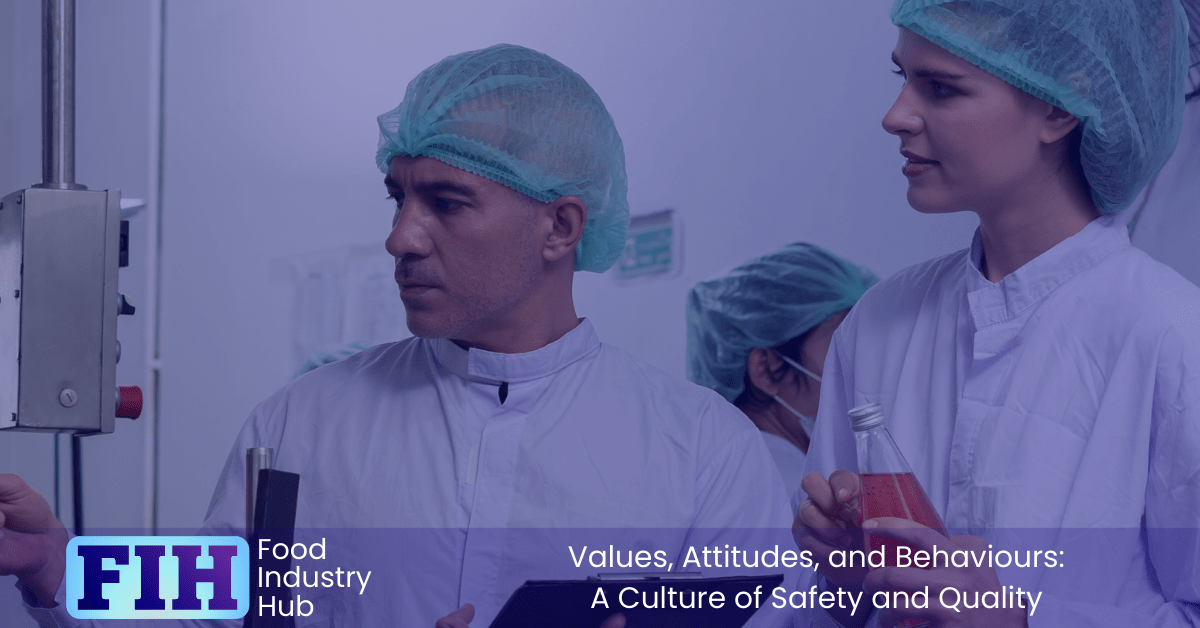
Attitudes and Dispositions
Let’s now turn our attention to attitudes and dispositions within your business. These play a crucial role in revealing the true values and ideals of your organisation.
Recognising How Values and Ideals Are Revealed Through Attitudes and Dispositions
Recognising how values and ideals reveal themselves through attitudes and dispositions is essential to understanding how a company’s guiding principles shape its culture, drive behaviours, and ultimately influence its success. Values and ideals may seem intangible, but their impact is observable in the attitudes and dispositions that individuals and teams exhibit across the organisation. These internalised mindsets act as the bridge between abstract principles and concrete actions, manifesting as everyday behaviours and decisions that align with the company’s mission and culture.
Attitudes and Dispositions as Indicators of Internalised Values
Attitudes and dispositions act as reliable indicators of a company’s values and ideals because they reflect the degree to which these principles are genuinely embraced, rather than superficially adopted. For instance, in an organisation that prioritises food safety and quality as core values, employees often display a proactive, meticulous approach to their work. This disposition shows up as an inherent attentiveness to detail, a willingness to double-check processes, and a readiness to speak up when safety standards might be at risk. Such behaviours are not merely the result of training or compliance requirements; they are rooted in a deep-seated commitment to the company’s ideals.
This proactive attitude, when widespread across a team, suggests that safety and quality are not just external demands but values that resonate with employees at a personal and collective level. When employees demonstrate these dispositions regularly, it reveals that they have internalised the values, allowing them to act with consistency and integrity, even in complex or ambiguous situations.
The Role of Disposition in Shaping Organisational Culture
The dispositions held by individuals and teams collectively shape an organisation’s culture, serving as a lens through which the company’s values are expressed. For example, in a food manufacturing business that values integrity and consumer protection, employees may exhibit a disposition of transparency and accountability. This means they are likely to take ownership of their actions, communicate openly about potential issues, and respond swiftly to address any quality concerns.
Attitudes like these not only foster a culture of trust and integrity but also reinforce the company’s commitment to high standards. When this disposition is consistently demonstrated, it builds a reputation that extends beyond the organisation, signalling to consumers and stakeholders that the company is dedicated to safety and quality. Thus, the cultural tone set by these dispositions reflects and strengthens the company’s values, becoming a powerful manifestation of its guiding principles.
Recognising Values in the Way Teams Approach Challenges
Values and ideals also reveal themselves in how individuals and teams approach challenges and navigate difficult decisions. In a company that values continual improvement and excellence, employees may demonstrate a disposition of resilience and innovation when faced with obstacles. Rather than viewing challenges as setbacks, they adopt an attitude of problem-solving, actively seeking ways to enhance processes and prevent future issues.
For example, if a team encounters a quality control issue, a disposition grounded in excellence will lead them to investigate thoroughly, apply corrective measures, and implement improvements to avoid recurrence. This behaviour shows that the team not only values quality as a principle but is committed to applying it as a standard in practice. Such dispositions reveal the underlying values that motivate employees to go beyond compliance, demonstrating that quality and improvement are not merely tasks to be completed but ideals that inspire a dedication to excellence.
Observing the Impact of Values on Decision-Making Attitudes
The influence of values and ideals on attitudes is particularly evident in decision-making contexts. Employees who genuinely embody the company’s values will approach decisions with a mindset that aligns with those principles. For instance, in a company that values consumer safety above all else, employees will approach decisions with a heightened sensitivity to risk. This risk-aware disposition leads them to prioritise safety considerations over cost savings or convenience, reflecting a mindset that places consumer protection at the forefront.
This disposition affects both individual and collective decisions, ensuring that actions taken by employees at all levels align with the organisation’s commitment to safety. Decisions made from this perspective reinforce the company’s reputation, as consumers and stakeholders come to view the business as one that consistently prioritises ethical considerations. Such attitudes and mindsets reveal that safety is not just an ideal but a core aspect of how the company defines its success.
Recognising Values Through Team Interactions and Communication
Values and ideals are also revealed in the ways employees interact with each other and communicate across teams. In organisations that value collaboration and respect, team members are more likely to exhibit a disposition of openness, support, and constructive feedback. They approach discussions with a sense of mutual respect, value each other’s perspectives, and collaborate toward shared goals without territorialism or defensiveness.
This collaborative disposition is especially evident in environments where safety and quality depend on cross-functional coordination, such as between production, quality assurance, and logistics teams. When employees display respect and empathy in their interactions, it shows that they value teamwork and understand that collective effort is essential for upholding standards. This disposition encourages a supportive work environment that strengthens the organisation’s culture and demonstrates how core values can guide interpersonal behaviours and team dynamics.
Assessing the Consistency Between Stated Values and Observable Dispositions
Recognising values through attitudes and dispositions provides an opportunity to assess the consistency between a company’s stated ideals and its lived experience. If the company proclaims that consumer safety and quality are its top priorities, yet employees frequently display attitudes that prioritise speed over accuracy or cost-saving over thoroughness, it reveals a disconnect. Conversely, when employees routinely demonstrate dispositions that align with these values, it indicates that the principles are truly embedded in the company’s culture.
Observing attitudes helps leadership identify areas where values may need to be reinforced or communicated more effectively. For example, if employees display hesitancy in reporting quality concerns, it may indicate a need to reinforce a value of openness and transparency. Recognising these gaps and addressing them aligns the organisation’s lived values with its stated principles, helping to create a culture of integrity where attitudes and dispositions fully embody the company’s ideals.
Attitudes and Dispositions as Reflective Measures of Values
The values and ideals of a company are most powerfully revealed not through written policies or mission statements, but through the attitudes and dispositions that employees exhibit in their everyday work. These mindsets reflect the extent to which values are genuinely internalised, serving as a compass that guides behaviours and decisions across the organisation. Recognising these dispositions enables leaders to see where values are truly integrated into the company’s culture, providing a lens through which the organisation’s commitment to its principles becomes observable, measurable, and continuously strengthened.
Through attentive observation and recognition of these values as they appear in attitudes and dispositions, companies can ensure that their guiding principles are not just aspirational statements but active, defining elements of their identity and operations.
Making Observations About the Attitudes and Dispositions Present Throughout the Business
Making observations about the attitudes and dispositions present throughout a food manufacturing business is a powerful way to understand and strengthen the organisation’s food safety and quality culture. This approach gives insight into the current state of the company’s culture and helps identify areas for growth. By examining the attitudes and dispositions of employees across different roles and levels, companies can see how well food safety and quality values are embedded in their operations. This insight forms the foundation for establishing a mature, resilient culture where these values are authentically expressed in every decision and action.
Observing Attitudes and Dispositions as Cultural Indicators
The attitudes and dispositions of employees serve as indicators of the underlying values within the organisation. For example, in a company with a strong food safety culture, employees display an attitude of vigilance, conscientiousness, and a proactive approach to identifying potential risks. If employees consistently prioritise thoroughness, accuracy, and safety over speed or convenience, it suggests that these values are genuinely internalised. This type of attitude signals that food safety is not just a compliance requirement but an integral part of the company’s identity and purpose.
Conversely, if employees frequently exhibit attitudes of complacency or indifference toward safety protocols, it can indicate a gap between the company’s stated food safety ideals and its operational reality. By observing these mindsets across teams and departments, food manufacturers can assess whether their values are effectively permeating the organisation or if they need reinforcement.
Identifying Dispositions That Support or Undermine Food Safety and Quality
Dispositions are the internalised tendencies that influence how individuals react to situations, follow protocols, and make decisions. In a food manufacturing environment, certain dispositions align strongly with a mature food safety and quality culture, such as attentiveness to detail, responsibility, and transparency. For example, employees who demonstrate a disposition of openness will be more likely to report quality issues, share insights, or raise concerns. These behaviours support a culture where food safety and quality are valued above expedience or convenience.
On the other hand, a disposition of risk tolerance, where employees downplay or ignore minor infractions, could undermine food safety initiatives. If employees habitually delay addressing non-conformances, it reveals a culture where safety values may be overshadowed by other operational priorities. Observing these tendencies helps leadership identify the need for cultural shifts, training, or reinforcement of core values to close the gap between desired and actual dispositions.
Using Observations to Define the Current State of Food Safety and Quality Culture
Observing attitudes and dispositions allows food manufacturers to define their current cultural state, forming a baseline from which they can build a more mature food safety and quality culture. For instance, if employees across various roles demonstrate a commitment to accurate record-keeping and regular process checks, it shows that attentiveness and accountability are well-aligned with the company’s values. These observations allow leadership to affirm positive dispositions and build upon them to strengthen the existing culture.
This baseline assessment can also highlight areas that need improvement. For instance, if quality control teams show high levels of engagement while production teams display more indifferent attitudes, it may indicate that food safety values are not uniformly understood or prioritised. By documenting these observations, leaders can tailor their improvement efforts, ensuring that all employees feel equally responsible for upholding food safety standards.
Supporting Cultural Development Through Targeted Reinforcement
Once a baseline of current attitudes and dispositions has been established, companies can take targeted actions to further develop their food safety and quality culture. Observing where gaps exist enables leadership to reinforce specific values through targeted training, communication, and role modelling. For example, if employees in certain roles display a disposition of efficiency over thoroughness, leadership might provide additional training on the importance of process accuracy in food safety. This approach clarifies the ‘why’ behind protocols, encouraging employees to internalise these values and approach their work with a safety-first mindset.
Observations can also inform recognition programs that celebrate employees who embody the company’s food safety values. By acknowledging those who demonstrate vigilance, accountability, or transparency, companies reinforce the desired dispositions, signalling to all employees that these attitudes are valued and rewarded. Over time, this positive reinforcement shifts the collective disposition of the organisation, contributing to a more mature and proactive culture.
Fostering a Culture of Continuous Improvement
A mature food safety and quality culture is not static; it requires ongoing observation and adaptation. By consistently observing attitudes and dispositions, food manufacturers can identify emerging patterns or shifts in employee mindsets. This vigilance enables the organisation to respond proactively, addressing potential cultural drifts before they impact food safety standards.
Continuous observation also supports a culture of improvement, as employees understand that their attitudes and dispositions contribute directly to the company’s overall success. When employees see that leadership is genuinely interested in fostering a culture of safety and quality, they become more invested in these values. This commitment creates a self-sustaining culture where employees feel responsible for upholding safety standards and continuously seeking ways to improve.
Linking Attitudes and Dispositions to Measurable Outcomes
Observing attitudes and dispositions provides valuable qualitative data that can be linked to measurable outcomes in food safety and quality. Positive dispositions—such as vigilance, collaboration, and thoroughness—are often correlated with lower rates of non-conformance, higher quality outputs, and fewer safety incidents. By tracking these outcomes alongside cultural observations, companies can demonstrate the tangible impact of a mature food safety culture, reinforcing the business case for investing in values-driven leadership.
Establishing this connection between culture and outcomes supports long-term commitment to food safety ideals, showing that these values lead not only to compliance but to operational excellence and business resilience. A culture that values continuous observation and reinforcement of food safety and quality ideals is positioned for sustainable growth, consumer trust, and lasting market leadership.
Building a Mature Food Safety and Quality Culture Through Observation
Observing the attitudes and dispositions throughout a business provides meaningful insights into the true nature of its food safety and quality culture. By identifying current dispositions, recognising areas for improvement, and consistently reinforcing core values, food manufacturers can cultivate a mature culture that goes beyond compliance to embrace food safety and quality as central pillars of their identity. Through ongoing observation, companies can transform abstract ideals into lived values that shape every action, decision, and outcome, creating a resilient, proactive, and consumer-centred food safety culture.
Challenging Whether Attitudes and Dispositions Truly Reflect the Businesses’ Stated Values
Examining whether the attitudes and dispositions within a business truly reflect its stated values is important for building an authentic food safety and quality culture. Values are the guiding principles that set the standard for expected behaviours and decisions. However, these values only hold meaning when they are actively embraced, resulting in observable attitudes and dispositions that align with the organisation’s ideals. A disconnect between values and behaviours can indicate that the company’s culture is at risk of becoming a collection of hollow statements rather than a living, guiding framework.
Values as the Foundation for Attitudes and Dispositions
Values serve as the foundation from which attitudes and dispositions arise. When a business declares food safety and quality as core values, it sets an expectation that employees across all levels will internalise these priorities, reflecting them in their everyday mindsets and actions. For instance, a company that values consumer safety above all else would expect employees to show vigilance and attention to detail in every process, whether in production, quality control, or distribution. This attentiveness demonstrates that employees are aligned with the company’s values and prioritise safety in their attitudes and actions.
However, if employees instead demonstrate a mindset of indifference or shortcuts —seeking efficiency over accuracy, or minimising risk concerns— this suggests a disconnect between the stated values and the internalised culture. This gap can often be traced to an inadequate communication of the values, a lack of reinforcement, or inconsistencies between what leadership says and what it prioritises in practice.
Challenging Whether Attitudes Truly Reflect Values
Challenging whether the attitudes and dispositions within the organisation reflect its values is essential for uncovering any misalignment. This means critically examining whether employees demonstrate behaviours that genuinely align with food safety and quality priorities or if they reveal unspoken cultural norms that contradict the stated values. For example, if employees show a disposition of avoiding responsibility for errors or hesitating to report safety concerns, it may indicate that transparency and accountability are not truly embedded values, regardless of what is stated in policy documents.
Conducting assessments of attitudes and dispositions across different departments can reveal these gaps. A structured feedback process, where employees can share their perceptions of the company’s values in practice, is invaluable for leadership. If employees consistently report that safety and quality take a back seat to speed or output, it becomes clear that the real drivers of behaviour may not align with the company’s declared values.
Evaluating Leadership’s Role in Reinforcing Values
Leadership plays a central role in ensuring that values are more than just written ideals — they must be actively demonstrated, supported, and reinforced. If leaders do not model the values they expect from their teams, it sends a signal that these principles are not authentically held. For instance, if leadership emphasises cost savings at the expense of rigorous quality checks, employees will sense that cost efficiency, rather than food safety, is the true priority. This inconsistency undermines the organisation’s credibility, making it difficult for employees to internalise the values in a meaningful way.
Effective leaders, by contrast, make decisions that consistently reflect the company’s values, reinforcing them through both words and actions. They prioritise safety and quality in all strategic planning, resource allocation, and performance metrics. Leaders also provide recognition for those who embody these values in their work, ensuring that employees feel supported in making value-aligned decisions. True alignment from the top sets the cultural tone, encouraging attitudes and dispositions that genuinely reflect the company’s stated values.
Establishing Accountability for Value-Driven Behaviour
Holding individuals accountable for behaviours that align with stated values is another fundamental aspect of ensuring that attitudes and dispositions faithfully reflect core principles. Accountability can be demonstrated through regular evaluations that assess not only technical performance but also how well employees uphold food safety and quality values. If employees know they will be recognised for value-aligned behaviours —and held accountable if they do not— there is a stronger incentive to internalise and demonstrate the company’s values in their daily work.
For instance, if attentiveness to safety protocols is a stated value, employees should be rewarded for going beyond compliance to enhance safety measures. Conversely, behaviours that undermine these values—such as overlooking safety checks to meet deadlines—should be addressed constructively, reinforcing that values are non-negotiable. This accountability mechanism underscores that values are not merely aspirational but are expected to guide each employee’s attitudes and actions.
Continuous Reflection on Values and Cultural Alignment
Because values are foundational yet subject to interpretation, regularly reflecting on and reinforcing these principles is essential to maintaining alignment. Food manufacturers can benefit from routine cultural assessments that evaluate whether employees’ attitudes and dispositions remain true to the organisation’s stated ideals. Through surveys, interviews, and team discussions, leadership can gather insights into how values are perceived and lived within the organisation.
This process of reflection also provides an opportunity to clarify and, if necessary, recalibrate values in light of shifting operational priorities or market demands. When employees see that leadership is committed to maintaining alignment between values and actions, they are more likely to believe in -and embody- these principles, cultivating attitudes and dispositions that reflect a strong commitment to food safety and quality.
Ensuring That Values Are Lived, Not Just Stated
Ensuring that a business’s values are genuinely reflected in employees’ attitudes and dispositions is a continuous, intentional effort. Values must be more than statements; they need to shape the mindsets and behaviours of individuals at every level. By critically examining whether attitudes and dispositions truly align with food safety and quality ideals, food manufacturers can identify gaps, adjust practices, and reinforce the values that form the foundation of their food safety and quality culture.
When values authentically drive attitudes, dispositions, and ultimately behaviors, the culture of food safety and quality becomes deeply embedded within the organisation, promoting a resilient, trustworthy brand. This alignment not only strengthens internal culture but builds a reputation for integrity and excellence, positioning the business as a leader in both product quality and ethical standards. Through consistent observation, reinforcement, and accountability, values can transform from ideals into guiding principles that shape every decision, interaction, and outcome, creating a true culture of safety and quality that permeates every aspect of the business.
Using Positive Reinforcement to Encourage Attitudes and Dispositions that Best Reflect the Food Safety and Quality Ideals of the Business
Using positive reinforcement to encourage attitudes and dispositions that reflect a company’s food safety and quality ideals is one of the most effective ways to embed these values deeply within its culture. Positive reinforcement not only motivates employees to uphold safety and quality standards, but it also cultivates an environment where individuals feel recognised, valued, and inspired to embody these ideals consistently. Reinforcing positive attitudes and behaviours ensures that values do not remain abstract principles but are continuously lived out through actions and decisions.
Encouraging Attitudes Aligned with Core Values Through Recognition
Positive reinforcement begins with recognising and rewarding the attitudes and dispositions that exemplify the company’s commitment to food safety and quality. This may include acknowledging employees who demonstrate attentiveness to detail, a proactive approach to identifying potential risks, or a dedication to quality even when it requires extra time or effort. By publicly celebrating these behaviours, whether through formal recognition programs, team meetings, or individual acknowledgments, the company communicates that these values are integral to its identity and success.
For example, if an employee identifies a potential quality issue before it impacts production, recognising their vigilance reinforces that the company prioritises proactive safety measures. This acknowledgment not only motivates the individual but also signals to other employees that the company values vigilance and responsibility, creating a ripple effect that encourages similar behaviours across the organisation.
Reinforcing Values Through Consistent Feedback and Mentorship
Feedback is another powerful form of positive reinforcement that helps guide employees toward dispositions that reflect the company’s values. Consistent, value-centred feedback —whether in formal performance reviews or informal coaching— helps employees understand how their attitudes align with or deviate from the company’s expectations around food safety and quality. Feedback that emphasises positive behaviours makes it clear that values such as transparency, accountability, and diligence are appreciated and rewarded.
Mentorship programs can further support positive reinforcement by pairing less experienced employees with mentors who exemplify the company’s values in their daily work. Mentors act as role models, demonstrating the dispositions that reflect food safety and quality principles and reinforcing them through hands-on guidance. This approach ensures that values are not just taught but are experienced firsthand, allowing employees to internalise the company’s ideals and feel confident in upholding them independently.
Celebrating Small Wins and Everyday Adherence to Food Safety Standards
Positive reinforcement is most effective when it recognises not only exceptional actions but also the small, everyday choices that demonstrate a commitment to food safety and quality. By celebrating these incremental efforts, companies make it clear that every action —no matter how routine— contributes to a culture of safety and excellence. Simple actions, such as ensuring proper sanitation or checking ingredient quality, may seem minor, but when recognised, they reinforce the company’s message that every detail matters.
Creating opportunities for team members to celebrate one another, such as through peer-nominated awards or ‘quality shout-outs’ encourages employees to value these daily practices. This approach also builds a sense of shared responsibility, as employees see that their peers appreciate and notice their efforts to maintain safety and quality. Over time, this habit of recognition cultivates a disposition of mutual respect and attentiveness, making safety and quality not just an expectation but a shared commitment.
Building Incentives Around Food Safety and Quality Excellence
Tangible incentives—such as bonuses, additional time off, or public recognition—are a powerful way to reinforce food safety and quality values. When structured thoughtfully, these incentives can motivate employees to consistently align their attitudes and actions with the company’s ideals. For instance, providing incentives for teams that achieve zero non-conformance rates or have exceptional audit scores helps establish a clear connection between values-driven actions and tangible rewards.
It’s essential, however, that incentives do not inadvertently encourage short-term compliance at the expense of genuine cultural alignment. The goal is not only to reward compliance but to foster an intrinsic commitment to food safety and quality. Balancing incentives with values-based feedback ensures that employees understand the deeper reasons behind safety and quality standards, driving authentic attitudes that align with the company’s long-term mission.
Creating a Cycle of Continuous Positive Reinforcement
Positive reinforcement should be an ongoing effort, with regular evaluations and recalibrations to ensure that it continues to promote the desired values and dispositions. This cycle of continuous reinforcement involves observing employee attitudes, providing consistent feedback, recognising aligned behaviours, and adjusting incentives to maintain alignment with evolving food safety and quality goals. Regular recognition of employees who demonstrate a strong alignment with the company’s values reinforces a collective sense of purpose, creating a culture where everyone feels empowered to contribute to the company’s mission.
Over time, this approach helps establish a resilient culture where employees are intrinsically motivated to prioritise food safety and quality. Rather than relying solely on external rewards, employees begin to internalise these values, viewing them as integral to their roles and professional identities. In this environment, values are no longer abstract principles but are lived out consistently, creating a self-sustaining culture of food safety and quality.
Embedding Values Through Positive Reinforcement for Lasting Cultural Impact
Positive reinforcement is a useful and constructive tool for embedding food safety and quality values within an organisation’s culture. By recognising and rewarding behaviours that align with core values, companies not only encourage desirable attitudes and dispositions but also encourage a work environment where these values become second nature. When employees feel consistently valued for their commitment to food safety and quality, they become more invested in these ideals, viewing them as fundamental to their professional roles and personal identities.
This approach transforms values from static statements into dynamic, living principles that shape every action and decision. As employees observe and internalise positive reinforcement, they develop a genuine disposition in favour of safety and quality, creating a culture where these ideals are authentically expressed at every level. Through continuous reinforcement, food manufacturers can build a resilient culture where food safety and quality are not merely regulatory requirements but are actively embraced as core values, ultimately building a reputation for integrity and excellence.
Using Social Feedback to Discourage Attitudes that are Incompatible with the Food Safety and Quality Values Held by the Organisation
Social feedback plays a pivotal role in discouraging attitudes that are incompatible with an organisation’s food safety and quality values. Unlike top-down directives, social feedback leverages the power of team dynamics to shape and reinforce behaviour, creating a self-regulating culture where employees collectively uphold food safety and quality ideals. When employees feel accountable to their peers as well as to leadership, they become more likely to align their attitudes and behaviours with the organisation’s values, leading to a culture of responsibility, accountability, and mutual respect.
Cultivating a Culture of Constructive Social Accountability
Creating an environment where team members feel comfortable providing feedback to one another helps establish social accountability. When employees know they can openly discuss safety or quality concerns without fear of retribution, it fosters an atmosphere where incompatible attitudes are constructively addressed. For example, if an employee consistently rushes through quality checks to meet production targets, their peers might feel comfortable reminding them of the importance of accuracy in maintaining food safety standards. This feedback, coming from colleagues who share the same responsibilities, can be more impactful than a formal reprimand, as it conveys that the team values quality and is committed to upholding it together.
To build this culture, leaders can encourage a feedback-friendly environment by modelling constructive, non-judgmental feedback themselves. Training sessions on giving and receiving feedback, coupled with clear guidelines on addressing issues professionally, can further reinforce this approach, helping employees feel empowered to speak up when they notice attitudes that don’t align with the company’s values.
Normalising Open Dialogue Around Food Safety and Quality Concerns
Open dialogue is essential for addressing incompatible attitudes early, before they become ingrained. Creating regular opportunities for teams to discuss food safety and quality openly helps normalise conversations that challenge attitudes that deviate from the company’s standards. These discussions can take place during team huddles, post-project reviews, or designated ‘safety and quality’ meetings, where employees share observations, concerns, and suggestions without singling anyone out.
By making these discussions part of the regular workflow, the organisation sends a clear message: food safety and quality are non-negotiable, and employees are encouraged to address any attitudes that could compromise these values. When employees see that their peers are willing to raise concerns openly, they are more likely to follow suit, gradually creating a culture where non-aligned attitudes are brought to light and addressed collectively.
Leveraging Peer Influence to Reinforce Positive Norms
In a team environment, peer influence can be a powerful motivator to align with shared values. Employees are more likely to modify incompatible attitudes when they see their peers upholding food safety and quality standards. Positive peer influence can discourage risky or indifferent attitudes and reinforce shared standards of excellence. For instance, when a team collectively prioritises thorough documentation or quality checks, individuals are less likely to skip steps because they feel a social responsibility to meet the group’s standards.
To strengthen this influence, leadership can recognise teams that exemplify food safety and quality values collectively, reinforcing that these ideals are group-held priorities. Encouraging employees to celebrate each other’s commitment to safety and quality also reinforces positive peer dynamics. When employees see that their actions —or inactions— affect the team’s success, they become more motivated to adopt attitudes that reflect the organisation’s values, and peer pressure can naturally discourage behaviours that do not align.
Addressing Incompatible Attitudes Through Peer-Led Coaching
Peer-led coaching programs can be highly effective in addressing attitudes that contradict food safety and quality values. By training certain employees to act as ‘values champions’ or peer coaches, companies create an informal layer of accountability and guidance. These champions, who exemplify the company’s values, can step in to address incompatible attitudes directly but constructively, helping peers understand how their attitudes impact safety and quality.
When an employee demonstrates an attitude that contradicts food safety or quality standards —such as a lax approach to documentation— a values champion might step in to explain why thorough records are vital to safety. This approach allows peers to learn from someone who understands their role, who is dedicated to upholding the company’s values, and who can communicate in a way that feels supportive rather than punitive. This informal coaching reinforces positive behaviours while discouraging attitudes that threaten food safety and quality.
Creating a Safe and Inclusive Environment for Social Feedback
For social feedback to be effective, employees must feel safe and supported when addressing incompatible attitudes. Leaders should emphasise that feedback, whether it addresses positive behaviours or areas of improvement, is always given in the spirit of upholding shared values. Providing channels for anonymous feedback, where employees can voice concerns about attitudes that compromise food safety and quality without fear of backlash, can help foster a more open environment.
Further to this, fostering a culture of inclusivity where every employee feels that their voice matters supports a more engaged, observant workforce. When all employees feel empowered to call out behaviours that threaten food safety and quality, incompatible attitudes are less likely to go unaddressed. This approach ensures that everyone plays a role in upholding the company’s values, making social feedback a normalised and constructive part of the company’s culture.
Reinforcing Social Feedback with Formal Support
Social feedback is most effective when it is reinforced by formal organisational support. Regular training sessions, clear policies, and leadership reinforcement validate the importance of peer-to-peer feedback and ensure it aligns with the company’s overarching goals. Additionally, HR and management should be prepared to provide support if incompatible attitudes persist despite social feedback. Knowing that formal structures exist to back up social accountability gives employees the confidence that their feedback will be taken seriously and will have a real impact.
Formal recognition programs that celebrate teams or individuals who actively use social feedback to support food safety and quality also strengthen the impact of peer influence. When employees see that using social feedback is valued and respected, they feel encouraged to engage more actively in maintaining high standards, helping to ensure that the organisation’s values are genuinely reflected in the culture.
Building a Self-Sustaining Culture Through Social Feedback
Using social feedback to discourage incompatible attitudes is a key element in creating a self-sustaining culture of food safety and quality. By fostering open dialogue, leveraging positive peer influence, and supporting peer-led coaching, companies can ensure that their values are more than just ideals. They become shared commitments that employees feel accountable to uphold for themselves and their peers. When incompatible attitudes are consistently addressed through social feedback, employees begin to view food safety and quality as collective responsibilities rather than mere obligations.
A culture built on this foundation is resilient, adaptive, and genuinely committed to upholding food safety and quality ideals. By embedding these values in the organisation’s social fabric, food manufacturers can create a strong, values-driven culture where every employee feels responsible for maintaining the highest standards. This commitment ultimately leads to greater accountability, better decision-making, and a safer, higher-quality product for consumers.
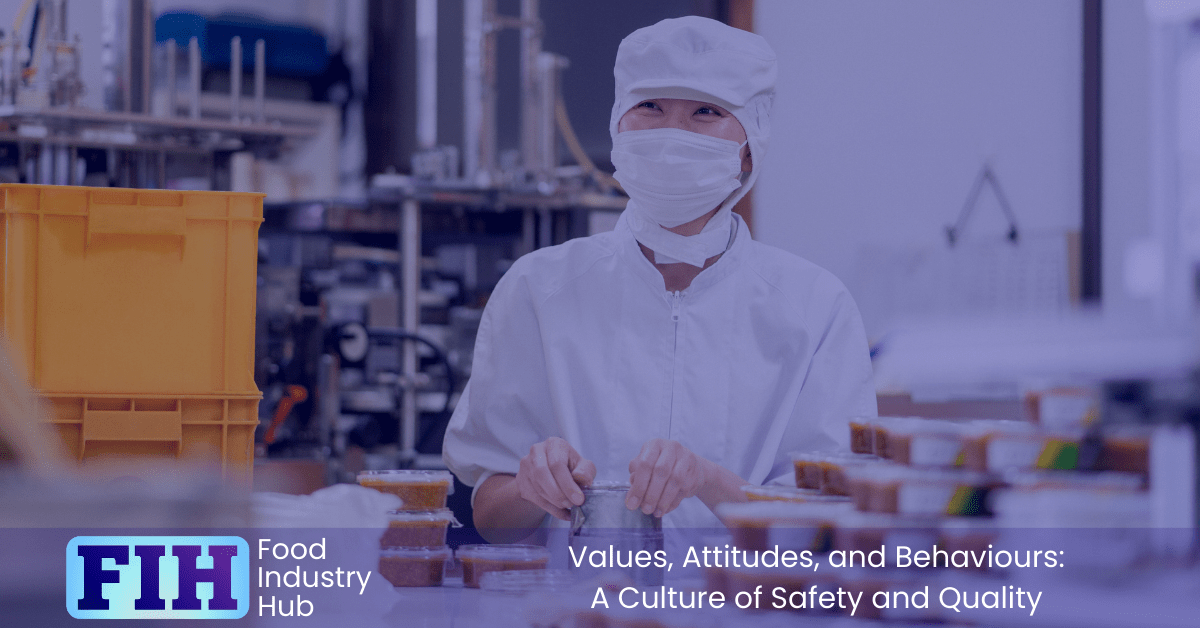
Sign-up for the Food Industry Hub Mail Service
We regularly produce new content for food industry professionals, and the Food Industry Hub Mail Service is the best way to stay up to date with the latest additions.
Signup today to be added to the Food Industry Hub mailing list.
Behaviours and Decisions
Now, let’s consider how behaviours and decisions reflect the safety and quality culture in your business.
Think about whether the actions you observe align with the food safety and quality ideals your company upholds.
Are these behaviours consistent and representative of the attitudes and dispositions you desire, or are they just isolated actions?
Inferring Attitudes and Values from Behavioural Observations
Observing behaviour in the workplace provides valuable insights into the underlying attitudes, dispositions, and, ultimately, the values that guide individuals and teams. This approach is particularly relevant in food manufacturing, where behaviours aligned with food safety and quality standards reveal the presence —or absence— of shared values and ideals. By examining everyday actions, companies can infer the dispositions held by employees and gauge how closely these dispositions align with the organisation’s core food safety and quality values.
Behavioural Observations as a Window into Attitudes and Dispositions
Behaviours are the outward expressions of internal attitudes and dispositions. When employees consistently demonstrate behaviours that uphold food safety and quality standards —such as adhering to protocols, double-checking details, and proactively addressing potential issues— it suggests an ingrained disposition toward responsibility and vigilance. These behaviours indicate that employees value precision, accountability, and safety, reflecting a positive alignment with the organisation’s ideals.
Conversely, behaviours that deviate from established protocols or disregard quality checks can reveal a lack of alignment with the company’s values. For instance, if employees frequently bypass safety checks to expedite production, it suggests that their disposition may lean toward efficiency over safety, indicating a potential misalignment with the company’s stated values around quality and safety. Recognising these patterns can help leaders identify gaps between declared values and actual practices, providing an opportunity to address and realign the workforce.
Identifying Consistency in Behaviours to Reveal Core Values
Core values tend to manifest in behaviours that are consistent, regardless of external factors like time pressures, individual goals, or production targets. When employees demonstrate the same commitment to food safety protocols during routine operations and high-pressure situations alike, it signals that these standards are deeply held values, not just situational guidelines. For example, an employee who meticulously documents procedures even when production is behind schedule is likely demonstrating a strong disposition toward accountability, reflecting a genuine commitment to quality.
This consistency in behaviour suggests that these values are not situational but are core to the employee’s —and potentially the team’s— work ethic. Observing these patterns over time allows leaders to identify which values have truly permeated the culture, distinguishing between values employees hold deeply and those they may only comply with externally.
Detecting Emerging Attitudes Through Behavioural Shifts
Behavioural shifts, especially when observed across a team or department, can indicate emerging attitudes or changes in collective dispositions. If, for example, employees begin showing greater attention to sanitation procedures after a company-wide training on food safety, this behavioural change may reflect an emerging attitude of increased caution and responsibility. This suggests that the training successfully reinforced the company’s commitment to food safety, encouraging employees to embrace the value of cleanliness as a shared responsibility.
Alternatively, if behaviours shift in ways that move away from the company’s values, this can signal the development of attitudes that may be at odds with the organisation’s goals. For instance, if employees become lax with quality checks following a change in production targets, it may indicate a shift toward prioritising speed over quality. Recognising these shifts early allows leaders to investigate the causes, reinforce core values, and realign attitudes with the organisation’s priorities before new, incompatible dispositions become ingrained.
Inferring Value Alignment Through Proactive Versus Reactive Behaviours
Proactive behaviours—those that go beyond basic compliance to actively support safety and quality—often reflect a stronger alignment with company values than merely reactive behaviours. Employees who take initiative, such as identifying and addressing potential hazards before they become issues, demonstrate a proactive disposition that indicates a high level of commitment to food safety and quality. This behaviour reveals that these values are internalised and actively influence the employee’s actions and decision-making.
On the other hand, reactive behaviours—where employees only address issues after they arise or when directed by others—can suggest that the values are not yet fully internalised. If an employee only complies with safety standards when monitored, it may indicate that the underlying disposition toward safety is weaker, potentially reflecting a need for further alignment with company values. Observing these distinctions allows leaders to pinpoint where reinforcement of core values is needed and recognise employees who truly embody the company’s ideals.
Observing Team Dynamics to Infer Shared Dispositions and Values
Team dynamics provide further insight into how values are collectively embraced and enacted. When a team consistently collaborates to uphold quality standards, such as assisting one another in identifying potential hazards or ensuring that safety checks are thoroughly completed, it suggests a shared disposition toward responsibility and teamwork, reflecting a group commitment to the company’s food safety ideals.
Conversely, if a team displays fragmented efforts—where individual members prioritise their own tasks at the expense of overall quality or ignore safety concerns—it may signal an absence of shared values, possibly reflecting an environment where attitudes toward food safety are inconsistent. Observing these team dynamics helps leaders identify whether food safety and quality values are embedded in group behaviour or if cultural alignment efforts should focus on building a stronger sense of collective accountability.
Using Behavioural Observations to Reinforce Food Safety and Quality Culture
Observing behaviours provides a practical means of inferring underlying attitudes and dispositions, giving companies valuable insights into how deeply food safety and quality values are embedded in the culture. By understanding how values shape everyday actions, leaders can assess whether the organisation’s ideals are truly influencing decisions and behaviours or if further reinforcement is needed. This approach empowers companies to strengthen their food safety and quality culture, ensuring that values move beyond stated principles to become core dispositions that guide consistent, proactive, and collective action.
When businesses regularly observe and interpret behaviour in light of their values, they create a feedback loop that reinforces alignment with core principles. Employees see that their attitudes are noticed and valued, fostering a workplace where food safety and quality ideals are not just expectations but are woven into the fabric of daily operations. Over time, this commitment to observing and reinforcing values creates a mature culture where every employee feels intrinsically motivated to uphold the highest standards in food safety and quality.
Critically Assessing Managerial Decisions for Compatibility with the Food Safety and Quality Ideals Held by the Business
Critically assessing managerial decisions for compatibility with a business’s food safety and quality ideals is a good way to ensure these values permeate all levels of decision-making. In food manufacturing, where decisions directly impact product safety, quality, and consumer trust, managers play a pivotal role in upholding the company’s core values. By rigorously evaluating managerial choices against food safety and quality principles, organisations can align operational priorities with their foundational values, setting a strong example for the entire workforce.
The Importance of Value-Aligned Decision-Making at the Managerial Level
Managers are often responsible for translating the organisation’s food safety and quality ideals into actionable policies and practices. Their decisions —ranging from resource allocation to procedural enforcement— directly impact whether these values are genuinely upheld or compromised under operational pressures. When managers consistently make decisions that reflect the organisation’s safety and quality values, it sets a tone for the entire team, reinforcing that these ideals are steadfastly held. Conversely, when decisions veer away from these values, it can create confusion and dilute the culture, signalling to employees that safety and quality may be compromised for other priorities, such as cost or speed.
By evaluating managerial decisions through the lens of food safety and quality ideals, companies can create a robust culture that reinforces these values as integral to every level of the organisation.
Establishing Transparent Decision-Making Criteria to Guide Managers
One of the first steps in aligning managerial decisions with food safety and quality values is to establish clear, transparent decision-making criteria that prioritise these principles. When managers have structured guidelines that emphasise safety and quality, they are more likely to make value-aligned decisions, even when facing competing demands.
For example, criteria might prioritise the completion of comprehensive quality checks before approving a product for distribution, regardless of time constraints. If managers understand that these checks are critical to the company’s commitment to quality, they are less likely to compromise this process under pressure. Transparent guidelines also create a framework for assessing decisions in retrospect, allowing organisations to identify and correct deviations from their ideals.
Conducting Regular Reviews of Managerial Decisions for Value Alignment
Regularly reviewing managerial decisions helps ensure they align with the organisation’s food safety and quality values. These reviews can occur in the form of monthly audits, team debriefs, or post-incident analyses that assess whether managerial actions consistently reflect the company’s ideals. For example, a review might focus on whether recent decisions around production timelines compromised quality checks or if cost-saving measures inadvertently affected safety standards.
By systematically examining decisions, organisations can identify patterns that may indicate alignment or misalignment with core values. When discrepancies are detected, managers receive feedback and guidance on how to better integrate food safety and quality ideals into future decisions. This practice creates accountability and reinforces the message that these values are foundational, not optional.
Assessing Resource Allocation Decisions for Commitment to Safety and Quality
Resource allocation is a critical area where managerial decisions reveal the organisation’s true commitment to food safety and quality values. Decisions about staffing levels, equipment upgrades, training budgets, and quality control resources directly impact an organisation’s ability to maintain high safety and quality standards. When managers allocate adequate resources toward these priorities, it signals that safety and quality are core values worth investing in, even when budgets are tight or production demands are high.
For instance, if a manager decides to delay an equipment upgrade that is essential for maintaining safety standards to meet cost targets, it may reflect an underlying prioritisation of budget over safety. On the other hand, a manager who reallocates funds from non-essential areas to enhance food safety training demonstrates an uncompromising commitment to these values. Regularly assessing resource allocation decisions in light of food safety and quality ideals helps organisations identify whether managers are investing in a way that aligns with the company’s commitment to excellence.
Evaluating the Consistency of Safety and Quality Emphasis in Decision-Making
Consistency is a key indicator of whether managers are truly aligned with food safety and quality values. When managers only emphasise safety and quality during audits or after incidents, it suggests that these values may not be genuinely integrated into the decision-making process. However, when safety and quality remain focal points across all decisions, including those made under pressure or in routine operations, it reflects a deeper commitment to these ideals.
To evaluate consistency, companies can examine how managers handle trade-offs. For instance, if a production target conflicts with the time required for thorough safety inspections, a manager’s response reveals much about their commitment to quality. A manager who consistently prioritises inspections, even if it means adjusting production goals, is demonstrating a value-aligned decision-making approach. Tracking these responses over time helps organisations ensure that food safety and quality remain central to managerial choices, regardless of circumstances.
Empowering Managers to Make Value-Aligned Decisions
For managers to consistently make decisions aligned with food safety and quality values, they must feel empowered and supported in doing so. When organisations create a culture where safety and quality are visibly prioritised and rewarded, managers are more likely to make choices that reflect these ideals without fear of negative repercussions. Leaders can reinforce this empowerment by explicitly recognising and rewarding decisions that uphold safety and quality values, even when they come with trade-offs.
Additionally, companies can provide training to help managers navigate complex decisions in alignment with core values. This training could include scenario-based workshops that simulate real-world challenges, allowing managers to practice decision-making in situations where they must balance competing priorities. By fostering a supportive environment and equipping managers with practical tools, organisations make it easier for managers to embody and act upon food safety and quality ideals.
Creating a Feedback Loop to Address Inconsistent Decisions
When decisions do not align with the organisation’s food safety and quality values, it’s useful to create a constructive feedback loop that addresses inconsistencies without punitive measures. If a manager makes a decision that compromises quality due to production pressure, leadership can use this as an opportunity to discuss the company’s values, analyse the root cause of the decision, and provide guidance on making value-aligned choices in similar situations in the future.
This feedback loop serves multiple purposes: it reinforces the importance of values, clarifies expectations, and helps managers understand how to align with the company’s ideals in complex situations. This process also demonstrates the company’s commitment to growth and learning, showing managers that value alignment is an ongoing priority.
Reinforcing Food Safety and Quality Values Through Managerial Accountability
Ensuring that managerial decisions reflect food safety and quality values is fundamental to creating a strong, values-driven culture supportive of food safety and quality. By critically assessing decisions, establishing transparent criteria, empowering managers, and fostering a culture of accountability, organisations make it clear that these values are not merely theoretical ideals but are central to every choice made at every level.
By holding managerial decisions to these high standards, food manufacturers can ensure that their commitment to food safety and quality extends through every layer of the organisation, resulting in a mature, resilient culture where every action aligns with core values. This commitment not only strengthens the organisation internally but also builds consumer trust, establishing the company as a leader in safety and quality excellence.
Challenging Whether Behaviours are Expressive of Desired Attitudes and Dispositions Toward Food Safety and Quality
While behaviours can appear compliant on the surface, a deeper analysis often reveals whether they stem from a true commitment to the organisation’s ideals or are simply the result of external pressures, temporary incentives, or mere procedural adherence. By critically examining behaviours, food manufacturers can gauge the authenticity of their food safety and quality culture, identifying areas where attitudes need realignment to foster a genuine, organisation-wide commitment to these core values.
Looking Beyond Compliance to Uncover True Dispositions
Compliance with food safety and quality protocols is essential in any food manufacturing environment, but adherence alone does not necessarily reflect a deep-rooted disposition toward these values. For example, an employee might follow safety procedures meticulously when being observed but fail to maintain the same standards when supervision is absent. Such behaviour indicates that compliance may be motivated by fear of reprimand rather than an intrinsic attitude of responsibility toward safety and quality.
Challenging behaviours by looking for consistency and proactive commitment helps organisations identify whether employees are truly aligned with the company’s values. Are they actively engaged in safety practices when not directly observed (or when they are not aware that they are being observed)? Do they take it upon themselves to improve processes or address potential issues without prompting? These observations reveal whether employees hold the desired dispositions or are simply fulfilling procedural requirements.
Identifying Behaviours Reflective of Intrinsic Versus Extrinsic Motivation
Intrinsic motivation —where actions are driven by internal values rather than external incentives— is a strong indicator that employees have internalised food safety and quality ideals. When employees demonstrate behaviours driven by intrinsic motivation, they are more likely to act consistently, prioritise safety, and take responsibility even under challenging circumstances. Extrinsic motivation, however, often results in behaviour that shifts depending on the presence of rewards, penalties, or external pressures. For example, employees who engage in rigorous quality checks only to meet audit standards may not be as vigilant when audits are not imminent.
By assessing the consistency of behaviours and distinguishing between intrinsic and extrinsic motivations, organisations can identify whether their workforce genuinely values food safety and quality. These kinds of assessments also help in identifying which attitudes require reinforcement to strengthen a shared commitment to these ideals.
Examining Proactive Versus Reactive Behaviours
Proactive behaviours —where employees take the initiative to prevent issues before they arise— often indicate a true disposition toward food safety and quality, suggesting that employees prioritise these values independently of external pressures. Conversely, reactive behaviours —where employees address issues only after they occur— can signal a lack of genuine engagement with the organisation’s ideals.
For example, an employee who proactively inspects equipment to prevent contamination demonstrates a disposition aligned with safety values, whereas one who only responds to maintenance alerts may be fulfilling a task rather than exhibiting a genuine commitment. By encouraging and recognising proactive behaviours, food manufacturers promote dispositions aligned with long-term safety and quality goals.
Recognising Behavioural Patterns That Signal Value Misalignment
Some behavioural patterns may reveal underlying attitudes that are misaligned with the company’s food safety and quality values. For instance, if employees frequently prioritise speed over safety during high-demand periods, it may indicate that they perceive production efficiency as more valued by management than quality. Observing these patterns can help organisations recognise when there is a disconnect between desired attitudes and actual dispositions, prompting leaders to revisit and clarify their values.
Regular feedback sessions and reflective discussions are effective ways to address these misalignments. By openly challenging the reasons behind certain behaviours, leaders can reinforce the importance of food safety and quality, encouraging employees to reflect on their actions and realign with the company’s ideals.
Encouraging Self-Awareness and Reflection Among Employees
Encouraging employees to reflect on their behaviours and question whether they genuinely reflect the company’s food safety and quality ideals is a powerful way to build alignment. When individuals take the time to consider whether their actions are consistent with core values, they are more likely to identify gaps between their behaviours and the organisation’s expectations.
For example, self-assessment tools, periodic peer reviews, or reflective exercises can prompt employees to assess their alignment with the company’s values. Such practices promote self-awareness, encouraging individuals to recognise when their behaviours may fall short of desired dispositions and take responsibility for aligning their actions with the organisation’s food safety and quality ideals.
Holding Managers Accountable for Value-Aligned Behaviours
Managers play a pivotal role in setting examples that reflect the desired attitudes toward food safety and quality. Their behaviours set the tone for the workforce, influencing employees’ perceptions of which values are truly prioritised. By holding managers accountable for decisions and actions that align with food safety and quality principles, organisations emphasise that these values are non-negotiable.
If a manager frequently overlooks quality checks to meet production quotas, it communicates to employees that expedience may take precedence over safety, regardless of stated ideals. Addressing these behaviours and challenging managers to model the right dispositions reinforces the importance of food safety and quality at all levels, making it clear that behaviours incompatible with these values will not be condoned.
Reinforcing Desired Behaviours to Cultivate Dispositions
To cultivate dispositions that reflect the organisation’s food safety and quality values, companies can use positive reinforcement to acknowledge and reward behaviours that exemplify these ideals. Recognising employees who go above and beyond to maintain safety standards or improve quality processes reinforces the message that these values are considered essential. This reinforcement encourages employees to internalise food safety and quality as personal standards, rather than external expectations.
Consistently celebrating and supporting behaviours that embody core values helps to shift dispositions toward a genuine commitment to food safety and quality. Over time, these practices build a culture where actions consistently reflect the company’s ideals, ensuring that values move from stated goals to shared beliefs across the workforce.
Ensuring Authenticity in Food Safety and Quality Dispositions
Challenging whether behaviours authentically express the desired attitudes toward food safety and quality is essential to creating a culture that genuinely upholds food safety and quality values. By critically assessing behaviours for consistency, motivation, and alignment, food manufacturers can gauge whether their workforce has internalised the organisation’s ideals or is simply complying with external expectations. Addressing discrepancies and reinforcing value-aligned behaviours promotes a culture where food safety and quality are not just procedural requirements but ingrained standards that guide every decision and action.
Through continuous observation, feedback, and positive reinforcement, food manufacturers can develop a workforce that not only adheres to but champions the company’s food safety and quality values, ensuring these ideals are deeply embedded in every facet of the organisation.
Drawing Conclusions About Actual Attitudes and Motivations Based on Observed Behaviours
Drawing conclusions about actual attitudes and motivations based on observed behaviours is an empirically substantiated practice for food manufacturers seeking to develop and sustain a robust food safety and quality culture. Observed behaviours provide essential insights into whether employees are motivated by a genuine commitment to the company’s ideals or merely fulfilling requirements out of obligation. By carefully analysing patterns in employee actions, companies can make informed inferences about the attitudes that drive these behaviours, uncovering underlying motivations and identifying areas where cultural reinforcement may be needed.
The Importance of Behavioural Analysis in Understanding Attitudes
Behaviours can be thought of as the visible expressions of underlying attitudes and motivations. In the context of food safety and quality, observing behaviours allows leaders to assess the extent to which employees have internalised the company’s core values. When behaviours consistently align with food safety and quality expectations —such as strict adherence to cleanliness protocols, proactive issue reporting, and a commitment to quality checks— these actions indicate that employees likely hold attitudes that prioritise safety and quality.
Conversely, inconsistent behaviours —such as cutting corners during high-demand periods or only adhering to standards when under direct supervision— may suggest a lack of internal motivation toward these ideals. By examining these patterns, companies can identify attitudes and dispositions that may not fully align with desired values, creating an opportunity for focused improvement.
Recognising the Indicators of Intrinsic Versus Extrinsic Motivation
Intrinsic motivation, where employees act out of a personal commitment to food safety and quality, usually results in consistent, proactive behaviours that persist regardless of external pressures. Employees who are intrinsically motivated demonstrate a strong sense of responsibility, even when it may require additional effort or slow down production. For example, an employee who takes the initiative to double-check labelling accuracy on a packaging line, without being asked, reveals an internalised commitment to quality.
On the other hand, behaviours driven by extrinsic motivation —such as following protocols solely to meet compliance requirements or avoid penalties— may appear compliant on the surface but are less likely to be consistent when external pressures shift. By observing these distinctions, companies can infer whether employees are genuinely committed to food safety and quality ideals or primarily motivated by external factors, guiding future initiatives to strengthen intrinsic motivation.
Identifying Behavioural Patterns That Signal Dispositional Alignment
When assessing employee attitudes toward food safety and quality, it’s helpful to look for behavioural patterns that indicate alignment with the organisation’s core values. For instance, consistent engagement in safety practices, active participation in quality discussions, and voluntary reporting of potential issues reveal a disposition that values these principles. These patterns are indicators that employees not only understand the importance of food safety and quality but are also inclined to support these ideals in their everyday actions.
Positive behavioural patterns suggest that employees’ attitudes are well-aligned with the organisation’s goals, supporting a strong culture of food safety and quality. When these behaviours are observed across teams, they signal a collective commitment to the organisation’s values, reinforcing a cohesive culture that prioritises safety and quality.
Observing Behaviours That May Reveal Cultural Gaps
Sometimes, behaviours indicate a lack of alignment with food safety and quality values, revealing potential gaps in the organisation’s culture. For example, employees who repeatedly overlook quality checks, avoid reporting minor safety issues, or neglect sanitation standards may signal that food safety and quality are not valued as highly as they should be. These behaviours can emerge from attitudes that prioritise speed, convenience, or cost-saving measures over safety and quality, suggesting that employees may perceive these operational factors as being more highly valued by the company.
Recognising these cultural gaps through behavioural observation allows organisations to address underlying issues, clarify expectations, and reinforce core values. Leaders can intervene to realign attitudes by communicating the importance of food safety and quality, encouraging accountability, and providing support to help employees internalise these ideals.
Assessing Managerial and Leadership Decisions for Cultural Consistency
Managerial and leadership behaviours serve as powerful indicators of organisational attitudes and priorities, as they set the tone for the entire team. When managers consistently make decisions that emphasise food safety and quality —such as prioritising thorough inspections over production speed or investing in staff training— they model a commitment to these values for their teams. Observing managerial decisions helps organisations assess whether leadership truly values food safety and quality or, instead, if there is an implicit emphasis on other priorities.
If managerial behaviours conflict with the business’ stated food safety and quality values, it sends mixed messages to employees, potentially undermining the organisation’s culture. By evaluating leadership decisions, companies can draw conclusions about the values being communicated and take corrective actions to ensure managers embody the organisation’s ideals. This practice reinforces a culture where food safety and quality are prioritised across all levels of the organisation.
Using Behavioural Observations to Guide Cultural Reinforcement
Once an organisation has identified gaps between desired and observed behaviours, these insights can be used to inform targeted cultural reinforcement initiatives. Training programs, team discussions, and continuous feedback can address specific behaviours that suggest misalignment with food safety and quality values. For example, if an analysis reveals that employees frequently neglect certain safety protocols under time pressure, targeted training can help reinforce the importance of these procedures, regardless of production demands.
By focusing on the attitudes behind behaviours, cultural reinforcement efforts can move beyond procedural compliance to foster genuine, lasting commitments. When employees understand the ‘why’ behind safety and quality practices, they are more likely to internalise these values and adjust their actions, accordingly, promoting a culture where food safety and quality are inherent, non-negotiable standards.
The Role of Positive Reinforcement in Cultivating Desired Attitudes
Positive reinforcement plays a critical role in fostering attitudes that support food safety and quality. Recognising and rewarding behaviours that reflect these ideals signals to employees that the organisation values and appreciates their commitment. For example, employees who consistently go above and beyond to ensure product quality or proactively address potential hazards can be acknowledged publicly or rewarded, reinforcing the importance of these actions.
This approach not only encourages value-aligned behaviours but also helps cultivate intrinsic motivation, as employees see that their efforts are valued and impactful. By strategically using positive reinforcement, companies can foster a culture where employees’ actions increasingly reflect genuine attitudes and dispositions toward food safety and quality.
Cultivating a Values-Driven Food Safety and Quality Culture Through Behavioural Observation
Drawing conclusions about attitudes and motivations from observed behaviours is an insightful way for food manufacturers to evaluate their food safety and quality culture. By analysing behaviours, companies can gauge whether employees’ attitudes align with the organisation’s ideals or if there are underlying cultural gaps that need addressing. Observing behavioural patterns, assessing consistency, and distinguishing between intrinsic and extrinsic motivation allow companies to make informed inferences about the true commitment of their workforce to food safety and quality principles.
By acting on these observations, reinforcing value-aligned behaviours, and addressing gaps, organisations can cultivate a mature food safety and quality culture where every decision, at every level, is guided by a shared commitment to excellence. This approach strengthens not only the integrity of the organisation but also builds trust with consumers, positioning the company as a reliable leader in safe and high-quality food production.
Distinguishing Between Isolated Actions and Behavioural Norms
Distinguishing between isolated actions and behavioural norms is essential for food manufacturers seeking to build a consistent and reliable culture of food safety and quality. While isolated actions may provide some insight into an individual’s choices or circumstances, they do not always reflect the deeper attitudes or norms of an organisation. Behavioural norms, on the other hand, reveal patterns over time that reflect collective values and expectations across the workforce. Recognising the difference allows companies to understand whether specific behaviours are occasional deviations or consistent practices that characterise the overall culture.
Isolated Actions: Understanding Outliers in Behaviour
Isolated actions are single events or short-term behaviours that, while observable, may not represent an individual’s or team’s usual approach. For instance, a quality assurance specialist who skips a thorough inspection during a high-demand period might typically prioritise food safety but, under unusual stress, momentarily compromises their standard. Similarly, an employee who excels in safety protocols may occasionally miss a step due to distraction or fatigue. Such one-off incidents often stem from situational pressures, resource limitations, or individual challenges, rather than from an entrenched attitude or disposition toward food safety and quality.
When evaluating isolated actions, it’s important to consider context and recognise that they do not always indicate a breakdown in values. Managers should address these actions to prevent repetition, but they should avoid generalising isolated incidents as behavioural norms. Rather, these outliers provide an opportunity to explore underlying issues, like workload, resource needs, or additional training requirements, which may help mitigate similar situations in the future.
Behavioural Norms: Identifying Patterns That Reveal Attitudes and Dispositions
Behavioural norms, unlike isolated actions, are patterns of behaviour that occur consistently across time, individuals, or teams. They reflect the organisation’s true culture and provide reliable indicators of the values held by employees. For example, if employees regularly prioritise efficiency over thorough quality checks, this behaviour likely signals a broader disposition toward production speed at the expense of safety. When a pattern of behaviour repeats, it suggests that underlying attitudes or unspoken expectations are influencing actions — often more strongly than any formal policy or procedure.
Behavioural norms are the ‘true pulse’ of an organisation, revealing what employees collectively believe is acceptable, encouraged, or expected. Identifying these patterns can help companies understand whether their workforce is aligned with food safety and quality ideals, or if misaligned priorities are undermining these values. Observing behavioural norms is particularly useful for revealing the difference between stated and practiced values, highlighting whether employees feel empowered to prioritise food safety and quality consistently.
Using Behavioural Observations to Draw Insights
To distinguish between isolated actions and behavioural norms, food manufacturers can implement systematic observations and regular feedback loops. For example:
- Routine Audits and Spot Checks: Conducting regular inspections and random checks allows management to observe employee practices over time. Observing consistent adherence to protocols in various contexts can confirm alignment with safety and quality standards. By contrast, frequent deviations during high-pressure periods may indicate a norm that places expedience above quality.
- Employee Feedback and Self-Assessment: Gathering feedback from employees through surveys or self-assessment exercises can reveal insights into the motivations behind behaviours. If employees repeatedly express feeling pressured to prioritise speed, this suggests a behavioural norm rather than isolated incidents. Feedback helps managers understand whether observed behaviours are driven by individual choice or broader organisational pressures.
- Consistent Documentation and Tracking: Maintaining detailed records of food safety incidents, quality assurance processes, and corrective actions provides a historical view of behaviour within the organisation. By analysing this data, companies can distinguish whether certain issues are recurrent across departments or limited to individual cases.
Addressing Norms that Conflict with Core Values
When behavioural norms are found to contradict the organisation’s stated food safety and quality values, it’s essential to investigate the root causes. If, for instance, teams regularly bypass certain quality checks, it may indicate a need to re-evaluate operational pressures, available resources, or incentives that unintentionally reward such shortcuts. Rather than viewing these behaviours as isolated non-compliance issues, recognising them as norms reveals a cultural gap that requires systemic change.
Effective interventions to address misaligned norms include:
- Clarifying Expectations: Re-emphasising food safety and quality values through regular training, clear communication, and visual reminders around the workplace reinforces expectations.
- Modelling Behaviour: Leadership and management should model the behaviours they wish to see, demonstrating a commitment to quality and safety even when under pressure. Consistent, value-aligned leadership encourages employees to adopt similar attitudes.
- Adjusting Incentives: If behavioural norms reflect a misalignment with values, incentive structures may need adjustment. Rewarding consistency, safety, and quality over production speed can shift norms in the right direction, encouraging employees to align their actions with core values.
- Cultivating Behavioural Norms Through Positive Reinforcement: Building a culture where food safety and quality are embedded requires reinforcing the behaviours that reflect these values. When employees see that their proactive efforts in maintaining high standards are recognised, they’re more likely to adopt these behaviours as part of the organisational norm. Recognising teams who consistently adhere to safety protocols or rewarding individuals who go above and beyond for quality assurance communicates that these actions are the expected standard.
Fostering a Consistent, Values-Driven Culture
Distinguishing between isolated actions and behavioural norms enables food manufacturers to make informed conclusions about their food safety and quality culture. While isolated actions offer insight into individual circumstances, behavioural norms reveal the collective attitudes, expectations, and dispositions that define the organisation’s culture. By actively observing and reinforcing norms that align with core values, food manufacturers can cultivate a culture where food safety and quality ideals are upheld consistently, even under challenging conditions. This approach ensures that values are lived out in practice, establishing food safety and quality as foundational elements of the organisation’s identity.
Determining Food Safety and Quality Culture Maturity from Behavioural Observations
Determining the maturity of a food safety and quality culture through behavioural observations is an effective way to gauge how deeply food safety and quality values are integrated into the day-to-day actions and attitudes within a business. By analysing patterns in employee behaviour, management decisions, and team interactions, food manufacturers can assess the extent of alignment between the organisation’s stated ideals and its practiced norms. A mature culture of food safety and quality is characterised by consistency, proactive engagement, and a genuine commitment across all levels of the organisation, indicating that values are not merely stated but actively upheld.
Defining Maturity in Food Safety and Quality Culture
In a mature food safety and quality culture, employees internalise these principles and exhibit behaviours that prioritise them consistently, regardless of operational pressures or external incentives. Maturity in this context means that employees’ actions reflect intrinsic motivation, where food safety and quality are viewed as non-negotiable standards rather than merely procedural requirements. At the management level, a mature culture shows through in decision-making processes that prioritise quality and safety even under challenging conditions – setting a tone that resonates throughout the workforce.
Conversely, an immature culture may exhibit inconsistent adherence to safety and quality standards, often driven by compliance requirements rather than intrinsic values. In such environments, food safety practices may be prioritised only when convenient or enforced, indicating that values have not fully permeated the organisational mindset.
Key Indicators of Culture Maturity Through Behavioural Observation
To evaluate culture maturity, organisations can monitor specific behavioural indicators at both individual and organisational levels:
- Consistency of Behaviour: In mature cultures, employees demonstrate consistency in following food safety and quality protocols. This consistency extends through routine activities as well as unexpected situations, such as a production delay or resource shortage. Consistent adherence to safety practices, even when they are time-consuming or challenging, indicates that food safety and quality are embedded values.
- Proactive Engagement and Problem Solving: Mature cultures encourage proactive behaviours where employees identify and address potential food safety and quality issues before they escalate. Employees in a mature culture feel empowered to speak up and are likely to report hazards, suggest improvements, or address minor non-conformances independently, reflecting a high level of ownership.
- Management Prioritisation of Values: In a mature culture, management decisions consistently reinforce food safety and quality, even when competing pressures like production speed or cost savings are present. Observing how managers allocate resources, respond to reported issues, and prioritise training and education in safety and quality provides valuable insights into the organisation’s maturity.
- Reaction to Deviations and Incidents: A mature food safety culture views deviations from protocol as learning opportunities rather than isolated failures. So, both management and staff treat incidents with a mindset geared toward improvement, examining root causes, implementing preventive actions, and engaging in open discussions about lessons learned. Observing how teams and managers respond to incidents or non-conformances reveals the culture’s commitment to continuous improvement.
- Employee Initiative and Ownership: In a mature culture, employees show a high degree of ownership over food safety and quality practices. They go beyond the minimum required tasks, engaging actively in training sessions, contributing ideas to enhance quality, and taking responsibility for product integrity. This ownership often manifests in employee-led quality circles, voluntary participation in improvement projects, and routine self-assessments.
- Peer-to-Peer Reinforcement: Mature cultures are characterised by collective accountability, where team members encourage each other to uphold safety and quality standards. Behavioural observations may reveal employees gently reminding each other to follow protocols, celebrating quality achievements, or collaborating to solve safety-related challenges, indicating that values have become an integral part of team dynamics.
Stages of Cultural Maturity: Behavioural Markers
Food safety and quality culture can be seen as progressing through several stages, with each level reflecting a different degree of maturity:
- Reactive Stage: At this stage, adherence to food safety and quality standards is minimal and primarily reactive, with employees following procedures only when supervised or after an incident has occurred. Observations may reveal that employees wait for instructions rather than taking proactive measures, and the focus is typically on compliance rather than genuine commitment.
- Compliance-Driven Stage: In this stage, the organisation demonstrates adherence to safety and quality standards but mainly due to regulatory or auditable requirements. Behaviours are typically consistent when audits are scheduled, or when management emphasises compliance, but employees may cut corners or deprioritise these standards in day-to-day activities. This stage indicates that food safety and quality values are externally enforced rather than fully embraced.
- Engagement Stage: In this intermediate stage, employees begin to show an understanding and appreciation for food safety and quality, with occasional proactive efforts. Some employees may volunteer to participate in safety committees, raise concerns about quality issues, or suggest improvements, but these behaviours may not yet be widespread or consistent across the organisation.
- Ownership Stage: At this level, employees and managers consistently demonstrate intrinsic motivation for food safety and quality, with proactive behaviours evident at all levels. Observations show that employees take responsibility for standards without needing direct supervision, managers make decisions prioritising safety and quality, and there is open communication about continuous improvement. This stage reflects a significant alignment between actions and organisational values.
- Integrated Stage: In the most mature stage, food safety and quality values are fully integrated into the organisational identity. The workforce, from leadership to front-line employees, is united in prioritising these principles, viewing them as essential to both personal and organisational success. At this stage, behaviours indicating a commitment to food safety and quality are second nature, with collective accountability and intrinsic motivation evident in every facet of operation.
Building Maturity Through Continuous Observation and Reinforcement
Determining an organisation’s culture maturity through behavioural observation is only the first step. To evolve towards higher maturity levels, food manufacturers can implement targeted strategies based on observed needs:
- Training and Education: Continuous education on food safety and quality values and practices can help employees understand why these standards matter, promoting a shift from compliance to intrinsic commitment.
- Open Communication and Feedback: Regular feedback loops, where employees can discuss challenges and receive recognition for value-aligned behaviours, promote a culture of shared responsibility. Leaders should be open to input on improving food safety practices, signalling that these values are part of a collaborative effort.
- Consistent Positive Reinforcement: Recognising and rewarding individuals and teams who exhibit mature behaviours reinforces these practices and encourages others to adopt similar dispositions. Positive reinforcement can include public acknowledgment, incentives, or development opportunities tied to contributions to food safety and quality.
- Modelling by Leadership: For employees to embody food safety and quality values, they need to see these values consistently modelled by leadership. When managers prioritise safety and quality in their decisions, employees are more likely to adopt similar attitudes.
Behavioural Observations as a Key Tool for Maturity Assessment
Assessing food safety and quality culture maturity through behavioural observations is an effective way for food manufacturers to understand and strengthen their organisational values. By identifying behavioural indicators across levels of maturity, businesses can recognise both strengths and areas for improvement, ultimately building a culture where food safety and quality are deeply rooted principles. Through consistent observation, reinforcement, and strategic development, organisations can advance their culture to reflect a high level of maturity, where every employee sees food safety and quality as fundamental, shared responsibilities.

In Summary
You’re shaping a safety and quality culture by clearly articulating food safety values, aligning them with business objectives, and setting clear expectations. These values guide your decision-making and challenge behaviours. By observing behaviours, you can gauge attitudes and motivations, distinguishing between isolated actions and norms. Through this, you’re not only promoting a culture of continuous improvement but also determining your organisation’s maturity in terms of food safety and quality culture.
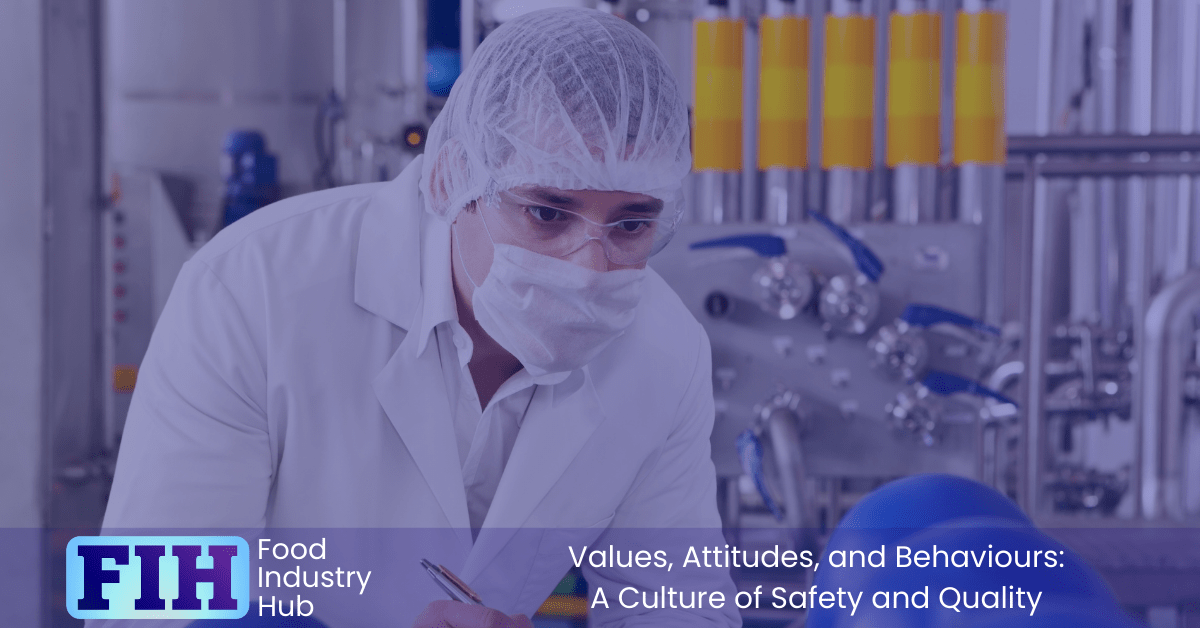
From The Food Industry Hub Knowledge Centre
Featured pages from The Food Industry Hub Knowledge Centre:
Further Resources
Food Industry Hub serves the food industry with a range of digital resources for the benefit of both commercial food manufacturers and food industry professionals.
For food manufacturers, we offer integrated management systems that give every user a direct interface with your QMS.
For food industry professionals, we provide an extensive signposting service in addition to informational content we hope you’ll find useful as you face new professional challenges. We have very ambitious plans to expand the range of services offered, and currently present informational content on management, safety and quality, food safety and quality culture, and professional success.

